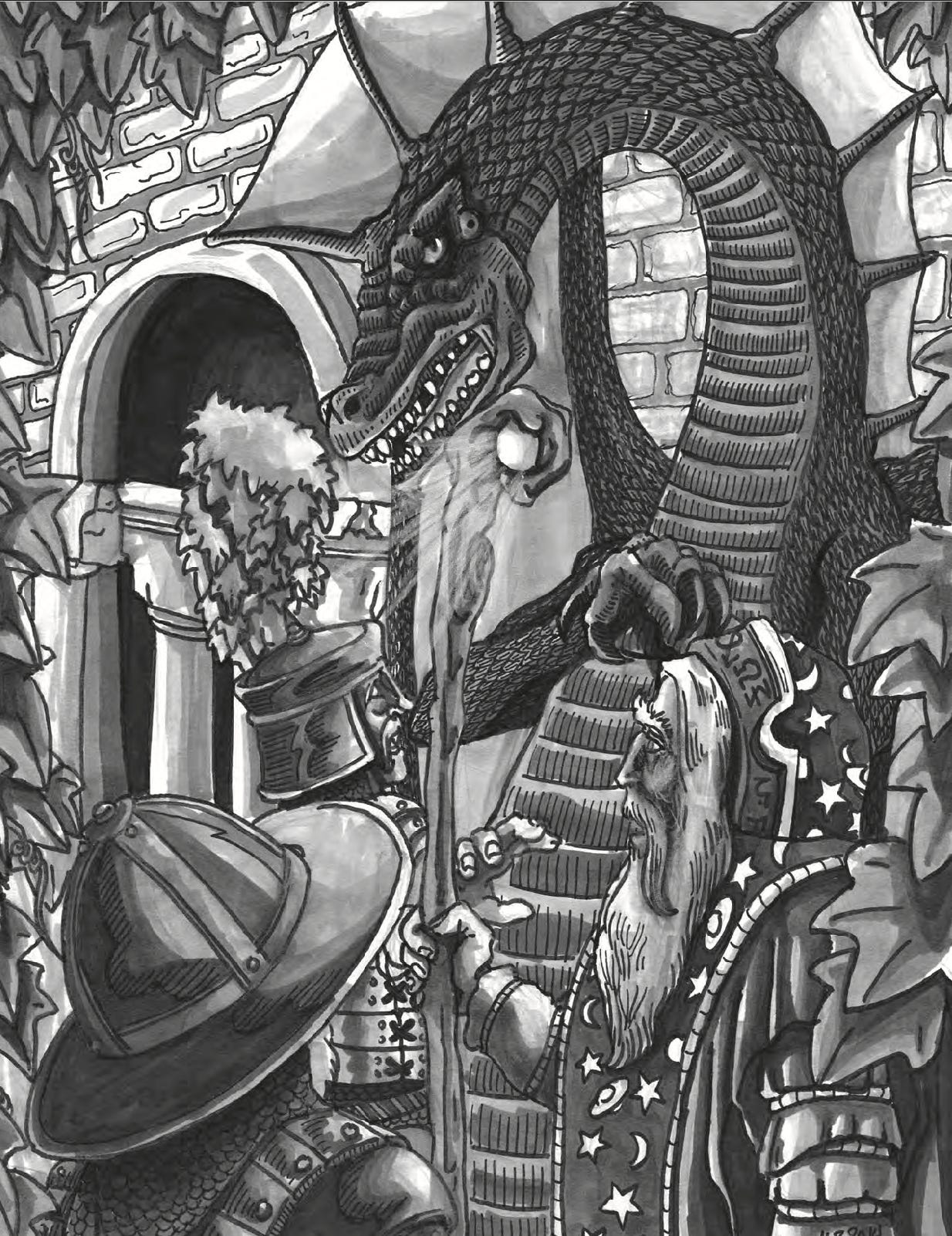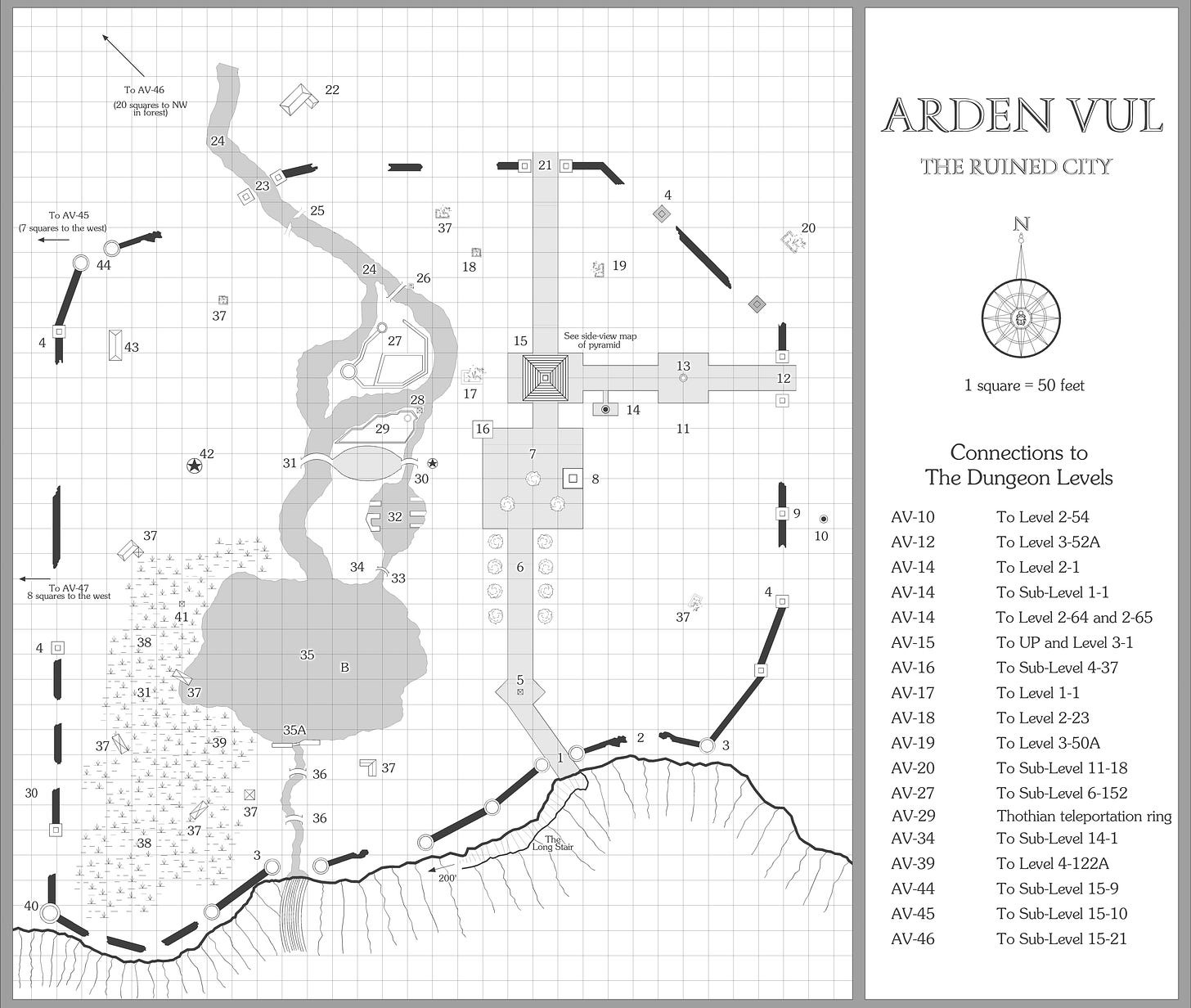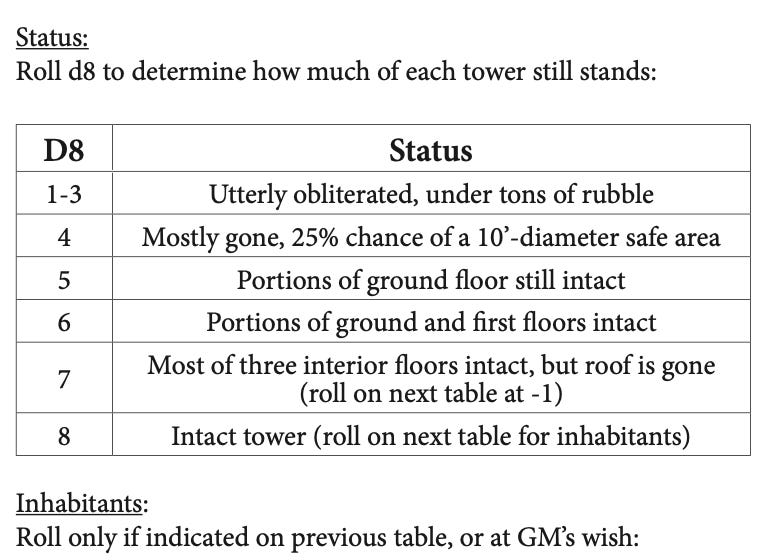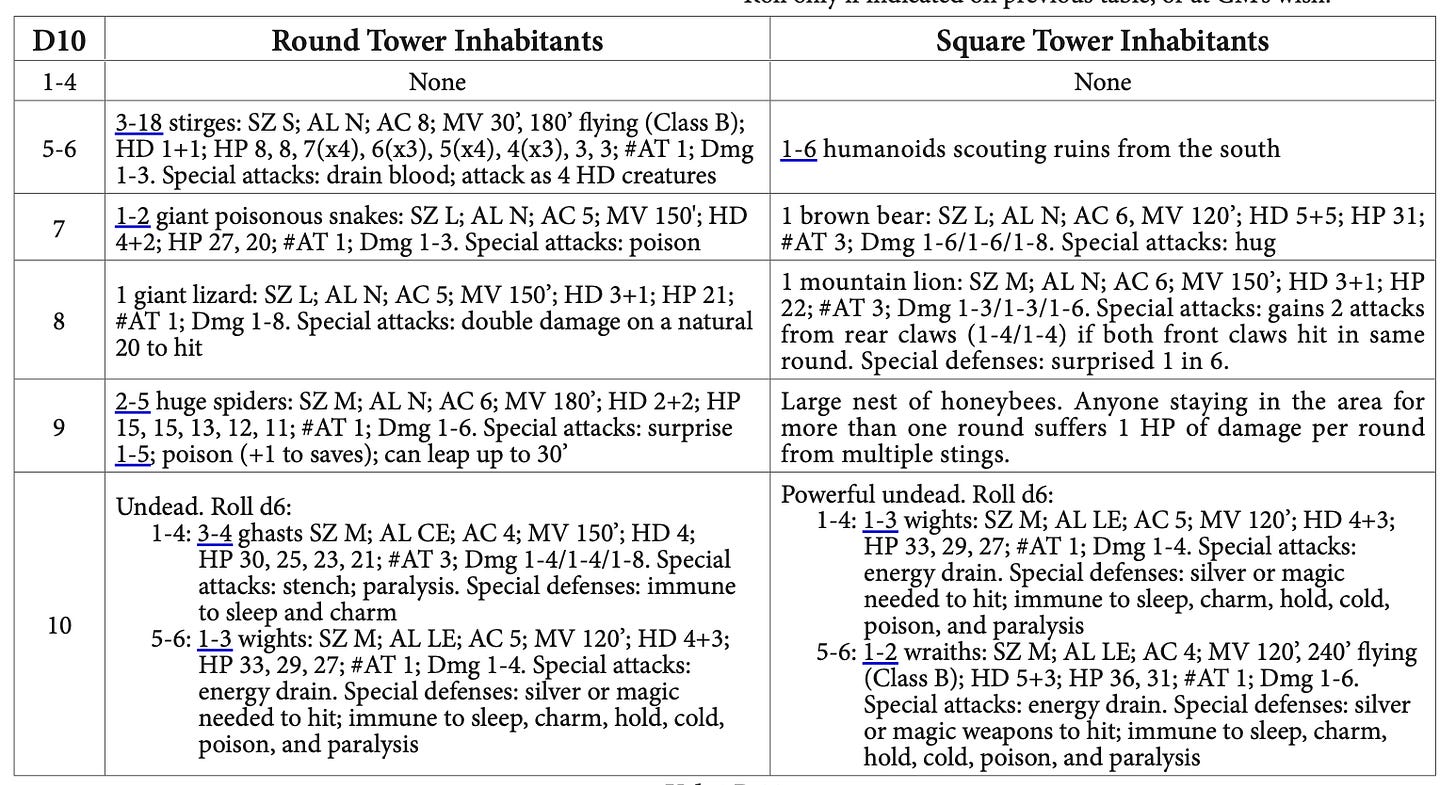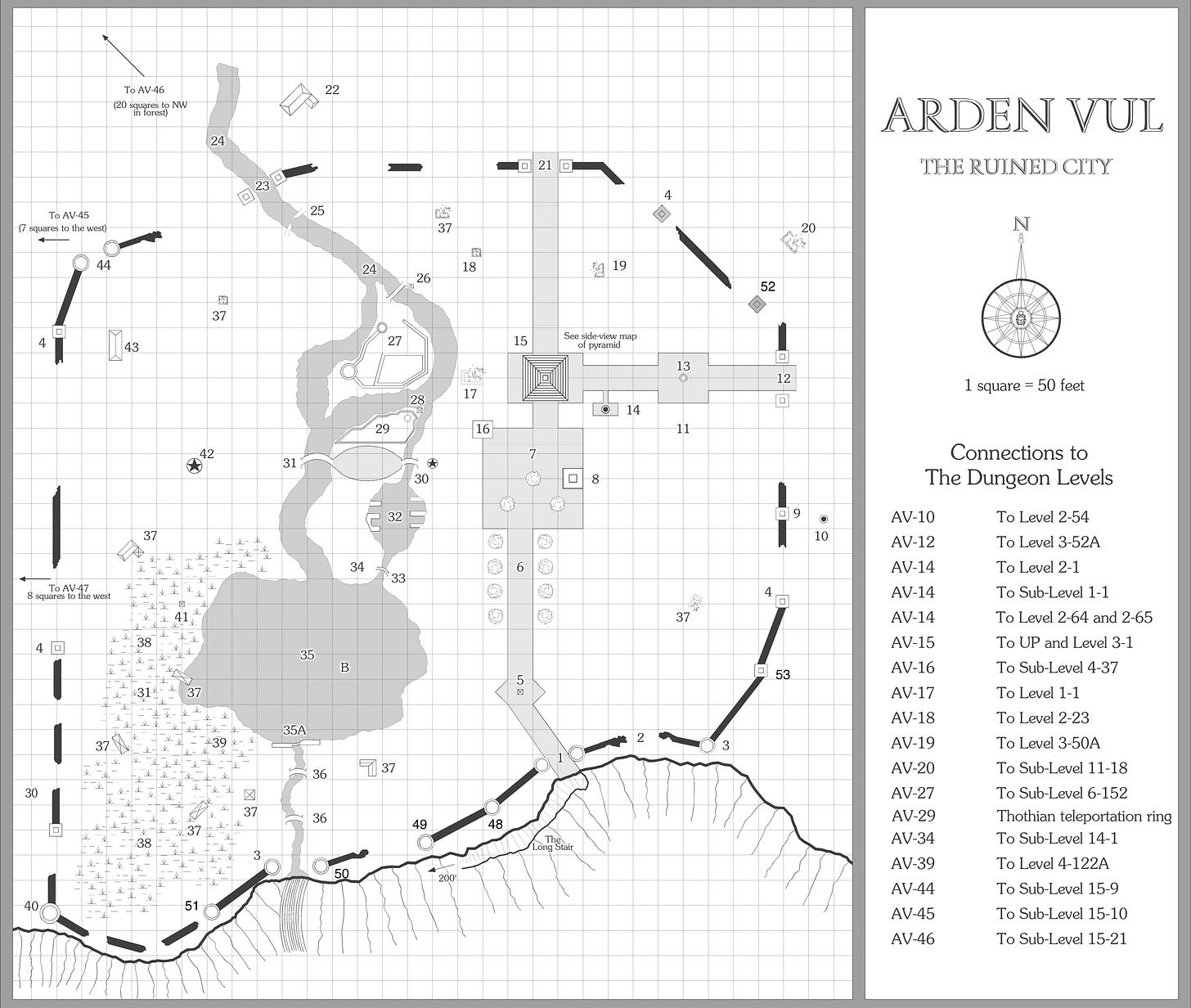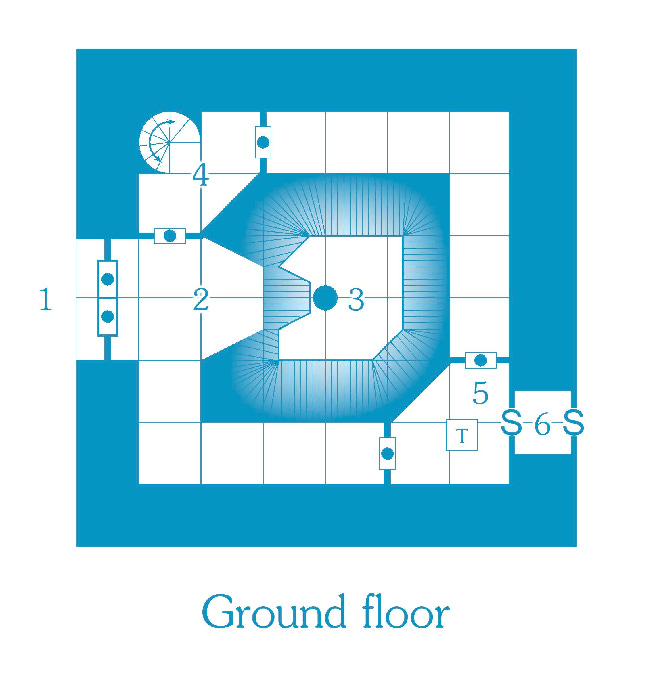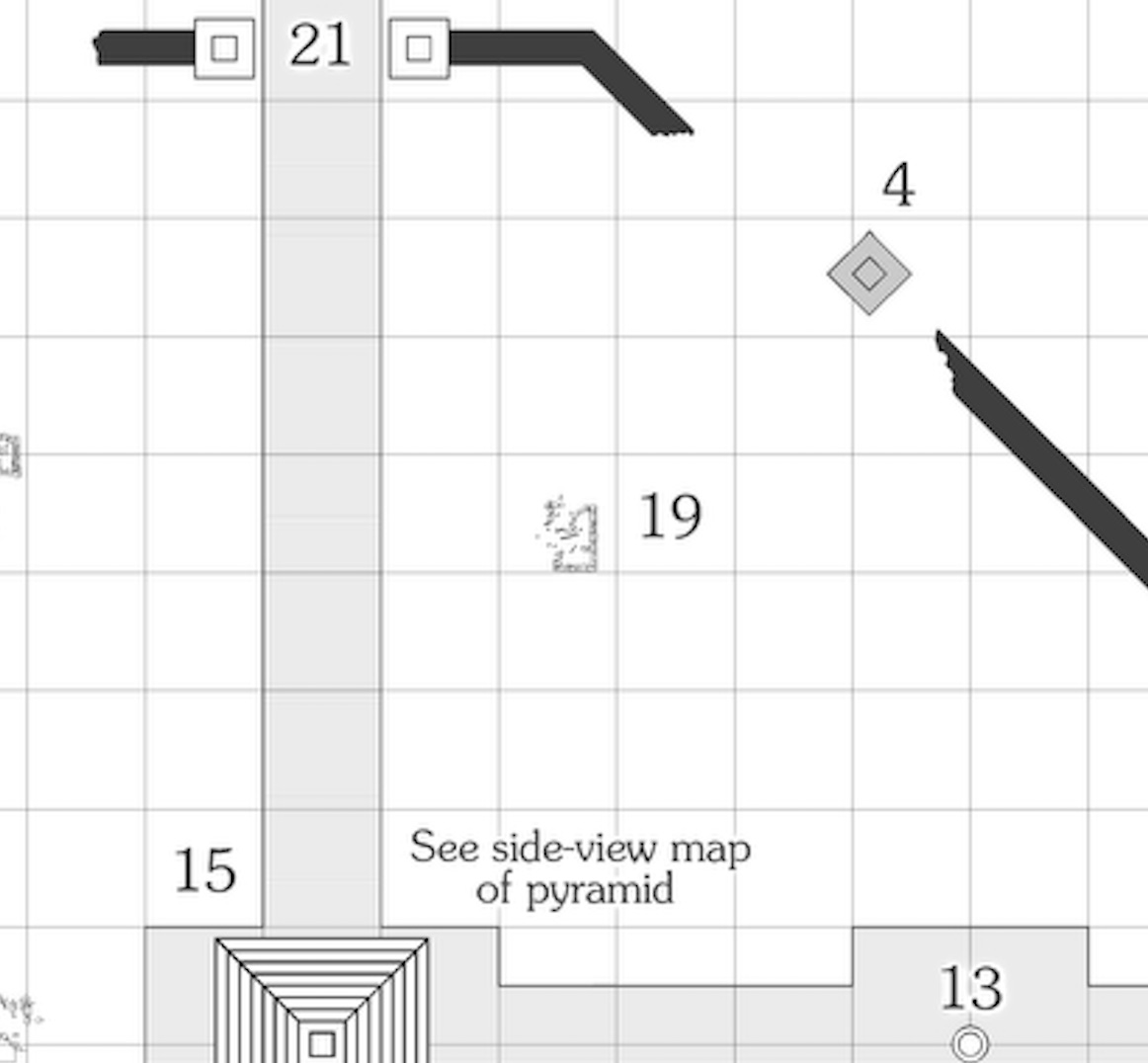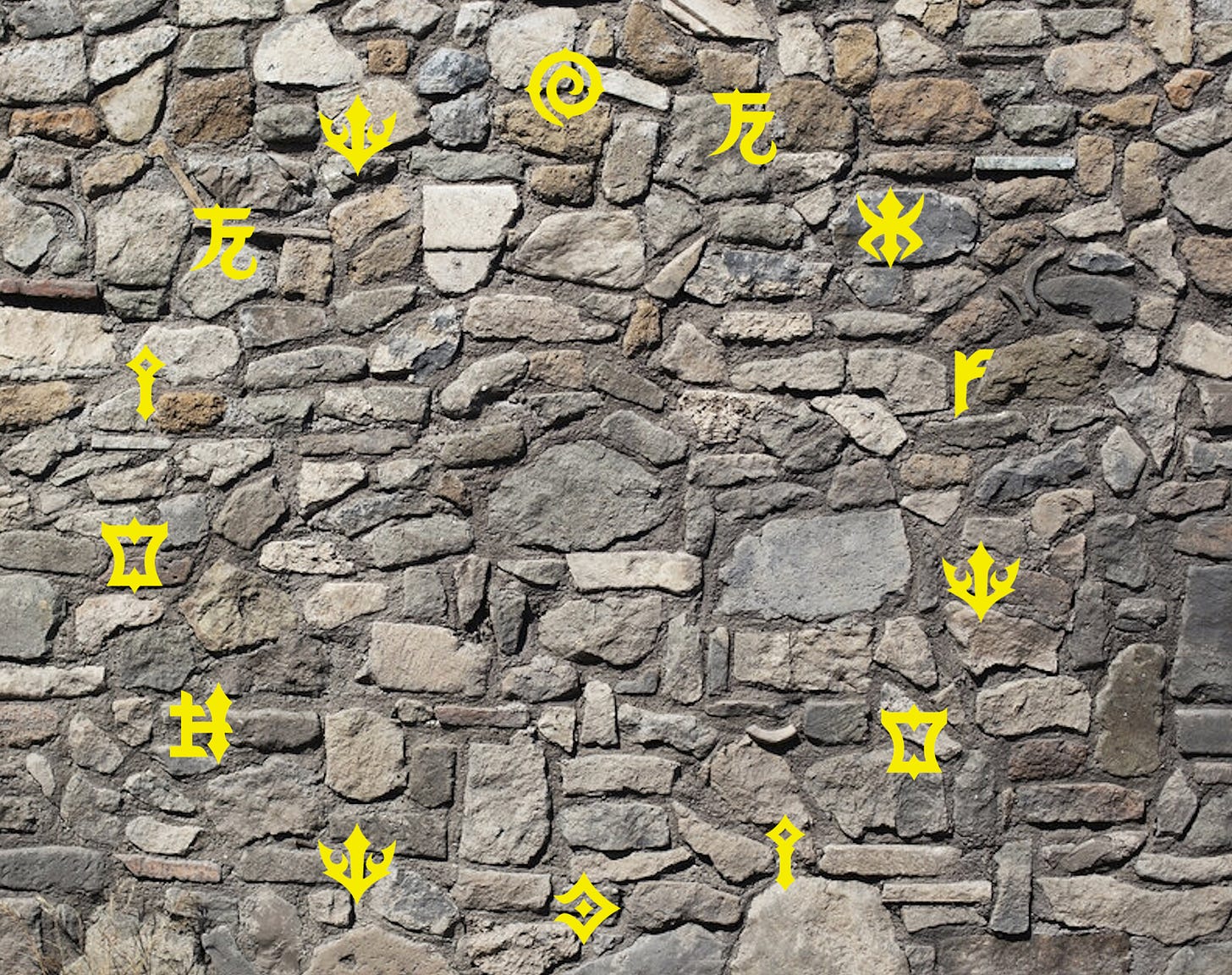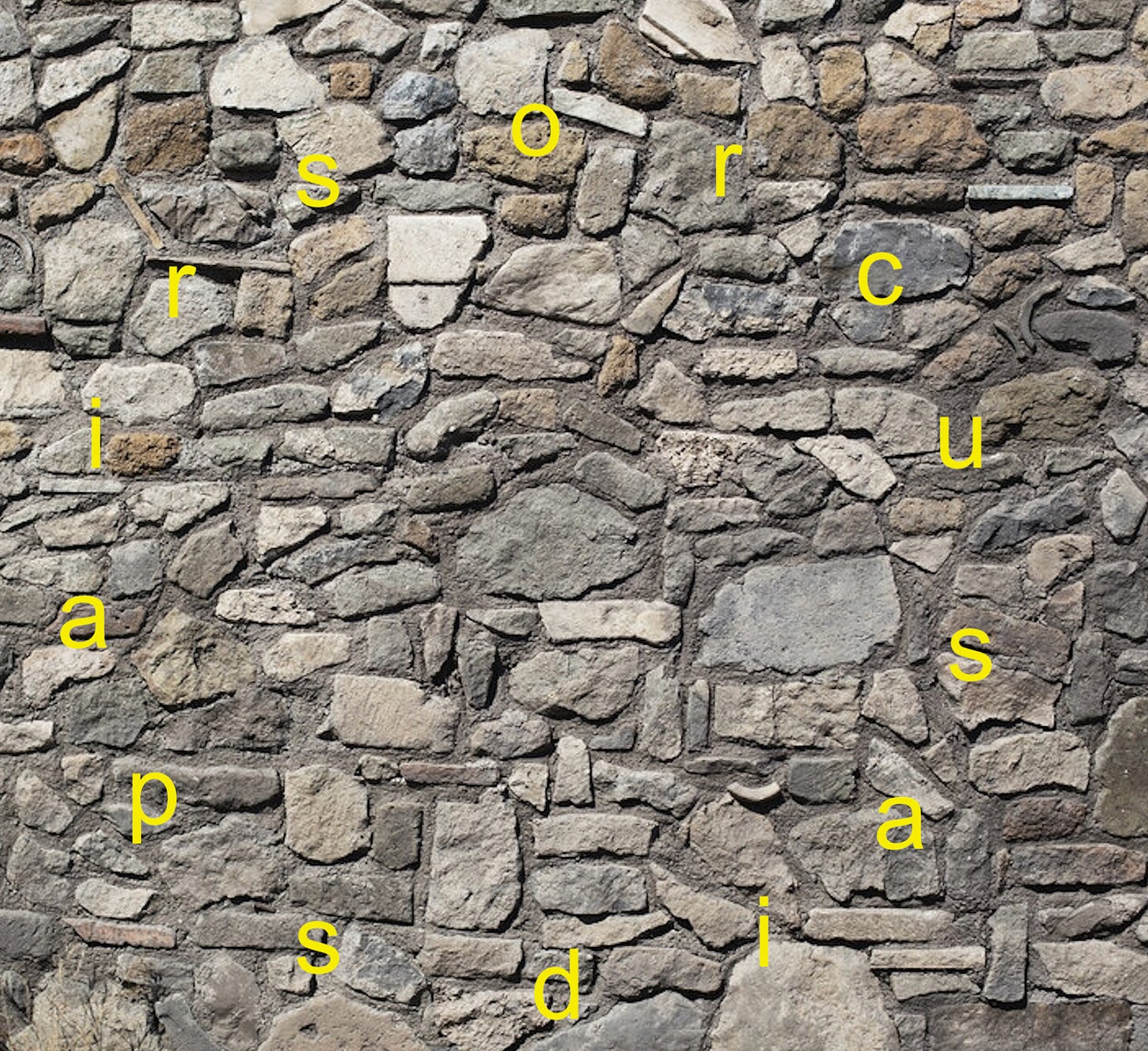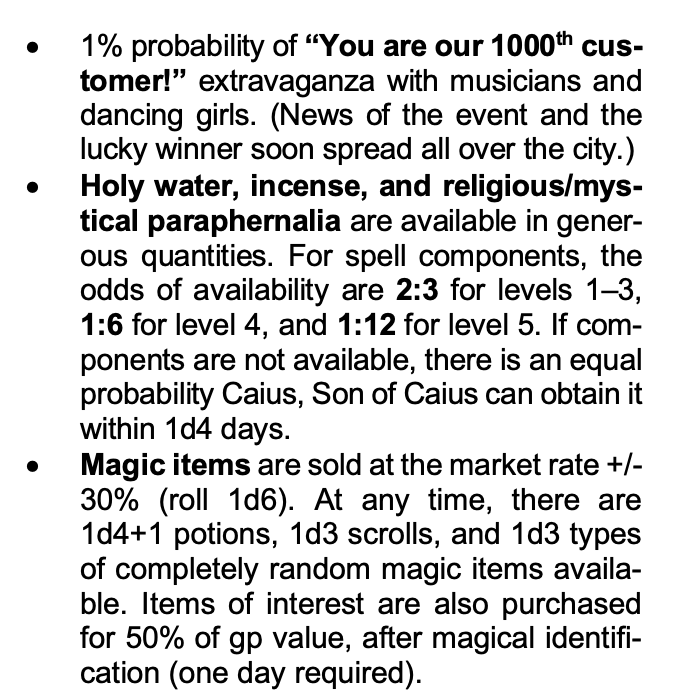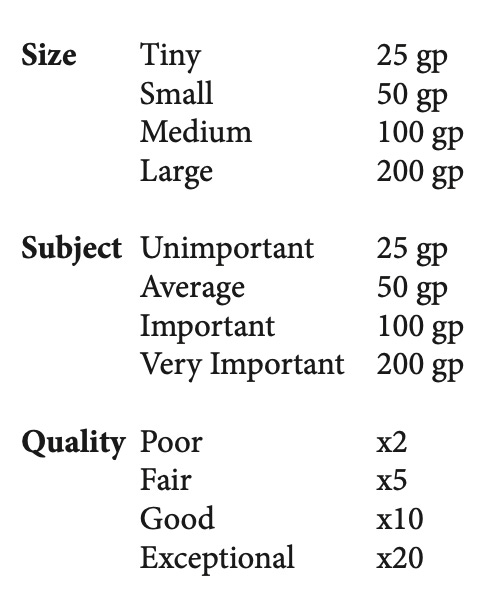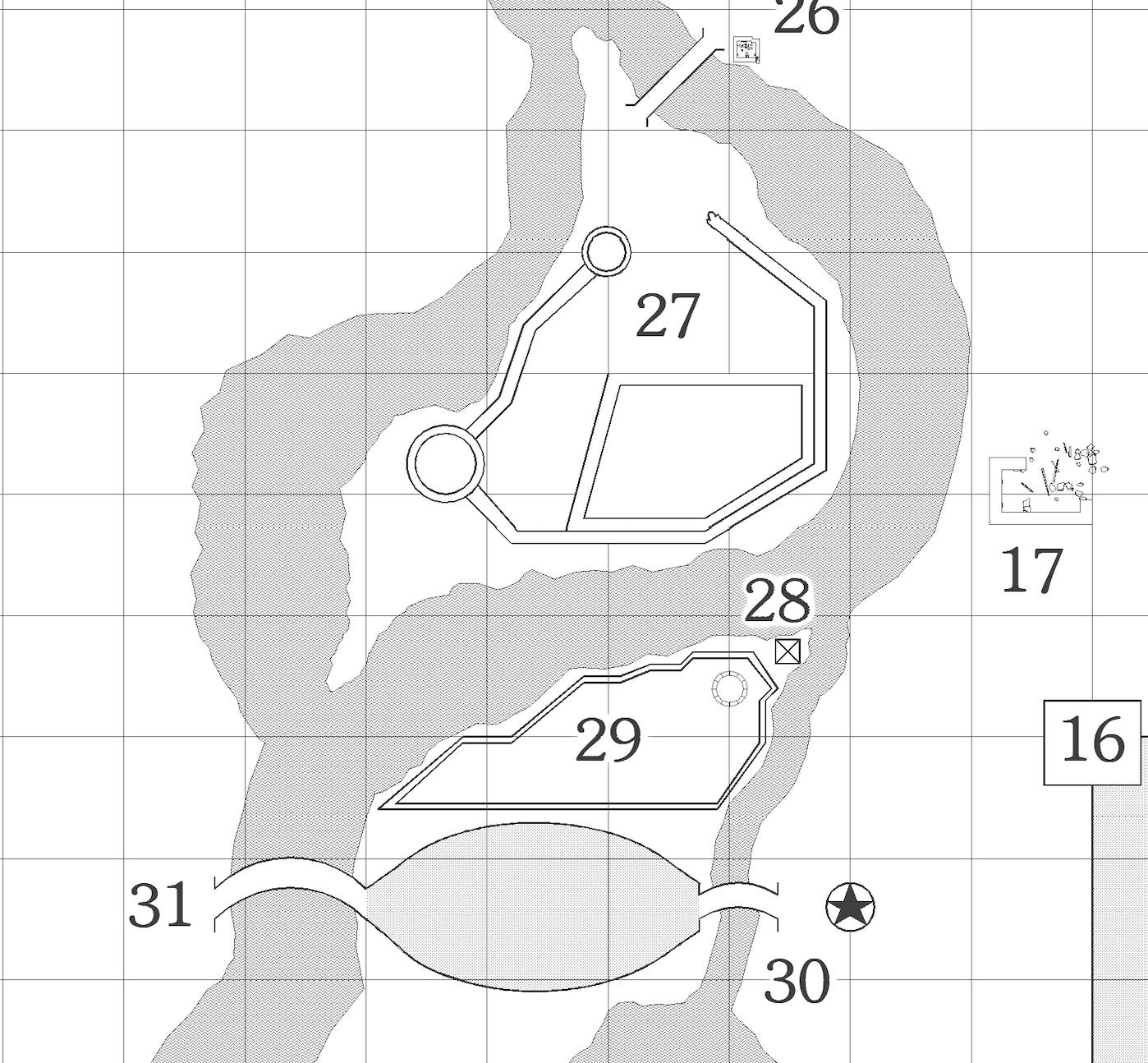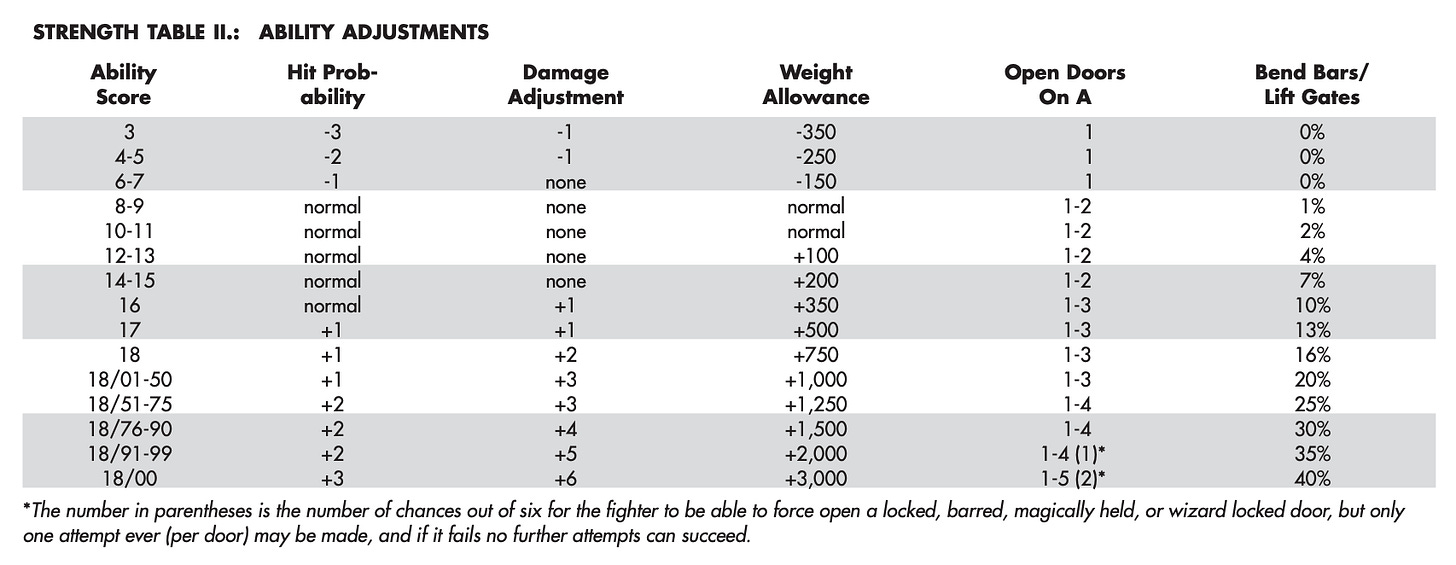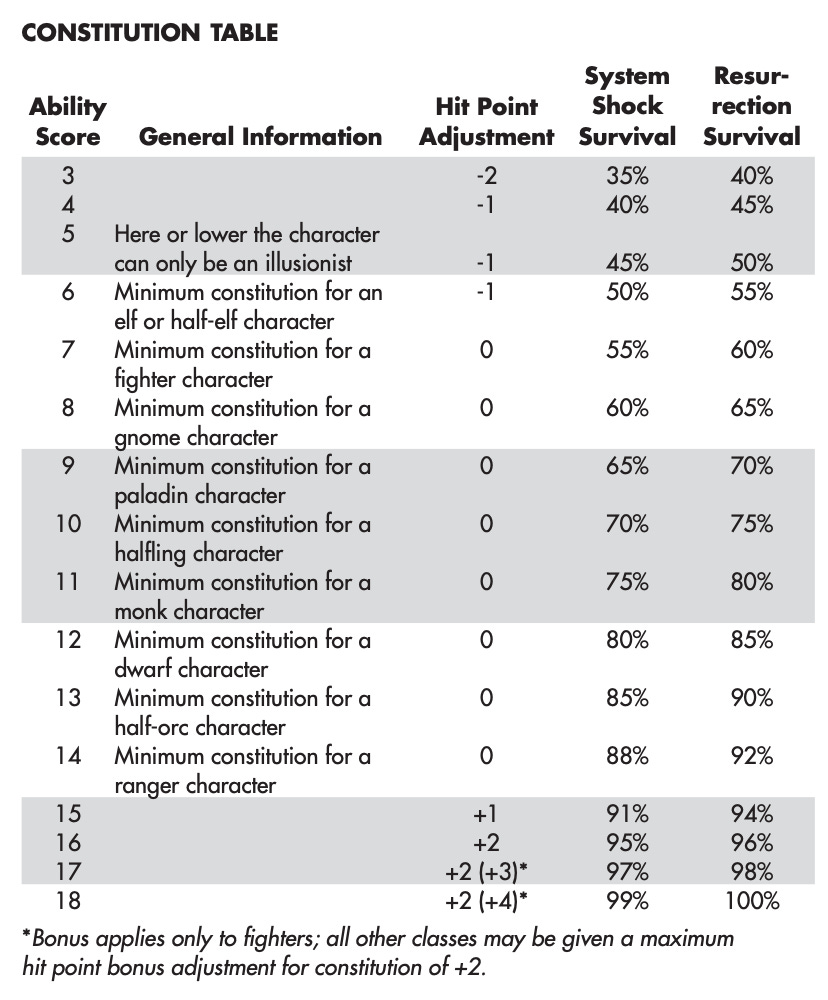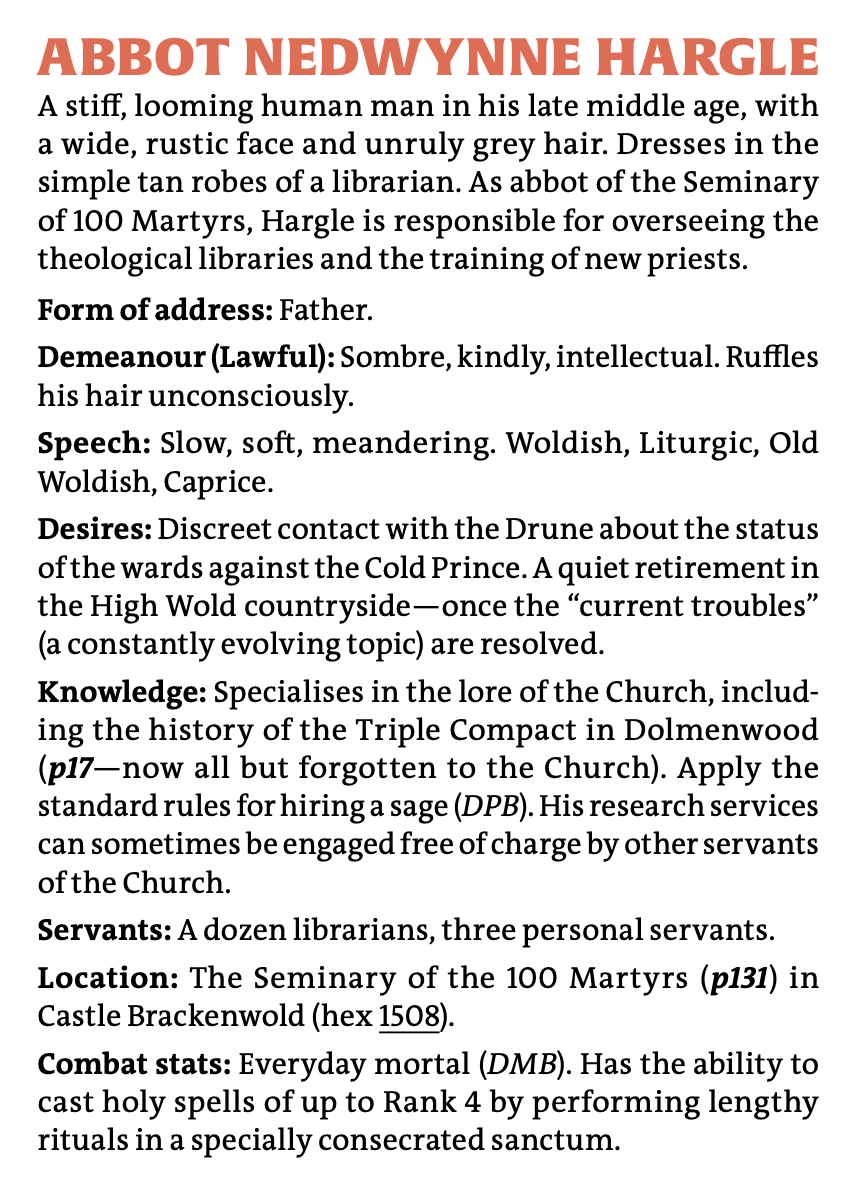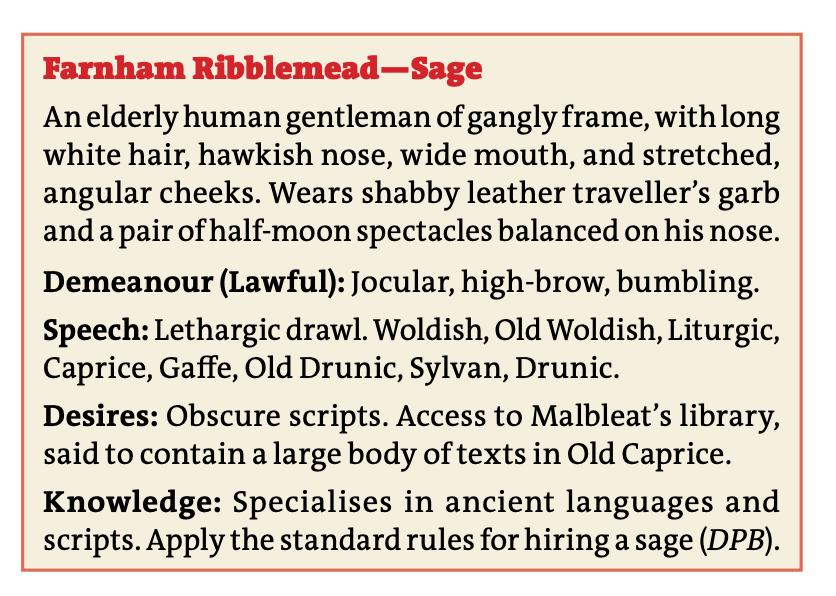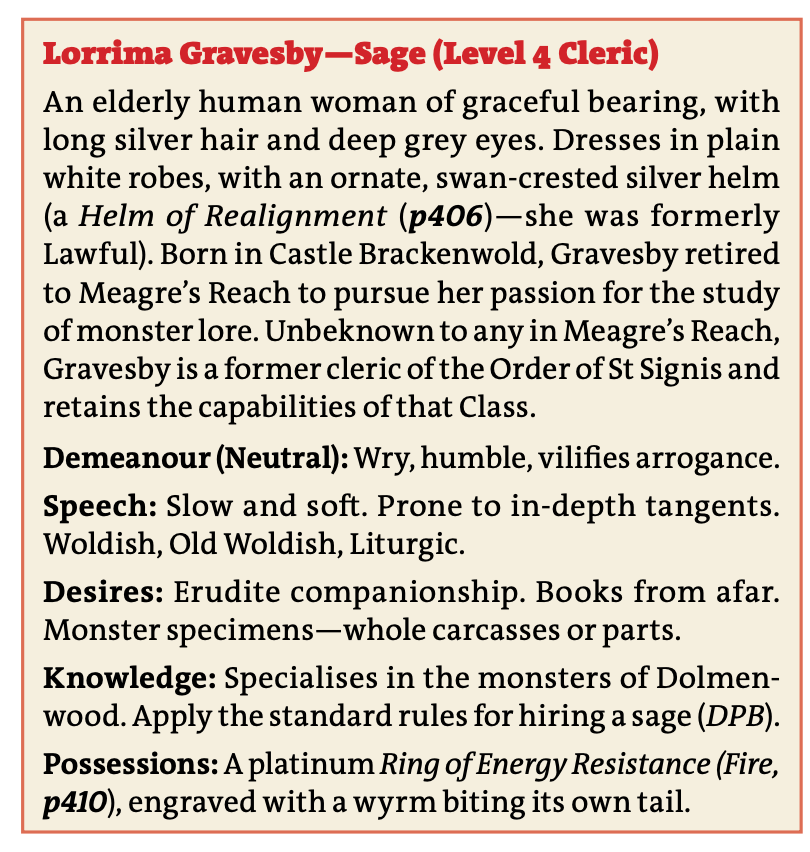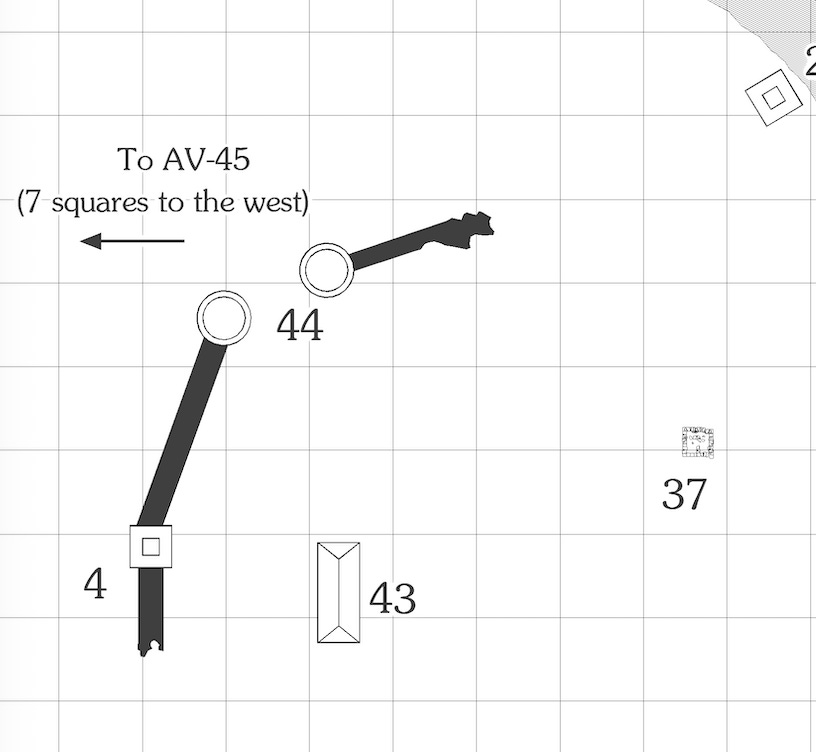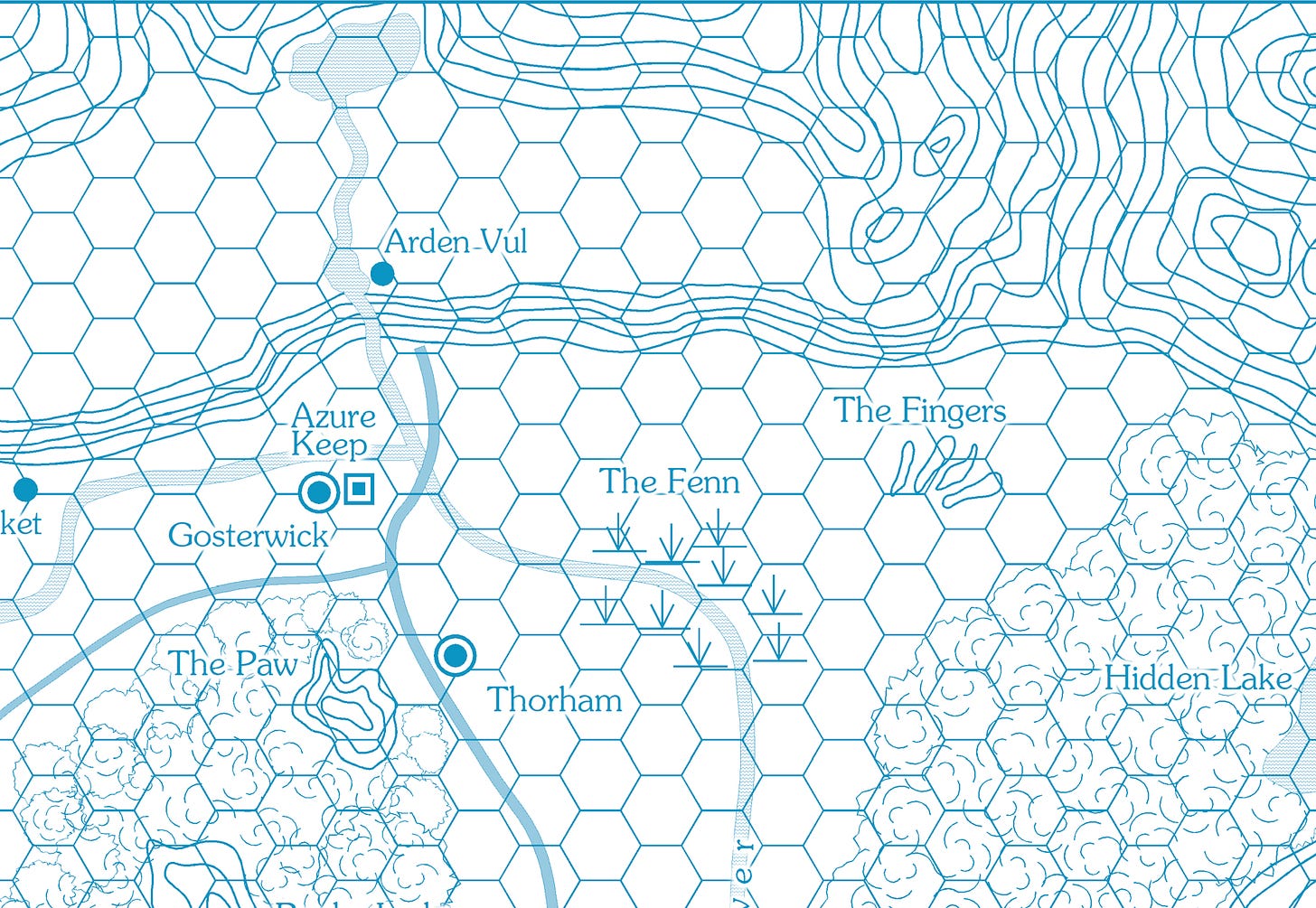Arden Vul - Ruined City
Overview
The module opens up with a 695-word, 7-paragraph overview of the Ruined City. In this, we learn:
Arden Vul served as a center for scholarly and magical pursuits, with a carefully selected population of ~10,000 at its peak. Necessities were imported through sorcery or from the valley below.
As the Archontean Empire declined, the city became a fortified retreat. It was ultimately torn apart by conflict between two factions: the Sortians, who wanted to make magical knowledge widely accessible, and the Theosophs, who wished to keep it restrictive and hierarchical.
The city was destroyed in a cataclysm 1,210 years ago. This event involved two forces: an enormous physical force that flattened the eastern side and immense heat that charred the western side.
An imperial expedition sent to reclaim Arden Vul approximately 250 years ago was destroyed in two decades.
Today, Arden Vul is a ruin. The western side is now a swamp, while the eastern side is in better condition. Several significant structures remain, most notably the Great Pyramid of Thoth, two obelisks, and the ruins of the imperial Archon's Palace.
I’ve scoured the book and can’t find an explicit note explaining what flattened the eastern side of the city. Here are the main clues that I’ve found:
“the east side (except the pyramid) seems to have been flattened by a wall of enormous force, as if a child has swept through a block-city with her hands” v1p81
“Everyone knows that the city of Arden Vul was destroyed during the War of the Sortians and Theosophs. But what isn't well-known is that the city was leveled to the ground by a phalanx of red dragons (T) commanded by the arch-Sortian, Priscus Pulcher (F). Some survivors managed to live on for a while underground, but they were eventually overwhelmed by giant trolls (T)”. Historical rumor 28, v1p26
1783 AEP, 1210 years ago. “The city of Arden Vul is brutally sacked by dragons and renegade Sortians during the war of Sortians and Theosophs. The archon, Uriel Basileon, dies in her palace. The varumani revolt under the mountain, expelling the Archonteans from the Lower Halls”. Timeline, v1p9
There’s some conflicting info here; the rumor says that the city was leveled by a phalanx of red dragons, while the timeline says it was a combo of dragons and Sortians. I think the “charred with immense heat” is fairly obviously the work of the red dragons, but it’s unclear what caused the immense physical force. Maybe a bunch of Bigby’s Hands from the Sortian wizards?
Finally, we get this note:
GM Notes on traffic and population in the Ruined City: It was tempting to make the ruined city the equivalent of another dungeon level in terms of monsters, treasure, and ‘special items.’ Indeed one could write dozens of additional encounters within the city ruins, as cellars abound; many of these were interconnected, potentially providing a goodly number of independent mini-dungeons. If such an environment is desired, pick a location in the ruins that is distant from any of the currently-keyed locations and bring that particular concept to life. The ruined city is large and can accommodate many more detailed areas.
But to keep the focus on the deeper dungeon levels, it seemed best that the ruined city serve as a relatively neutral location in which the PCs can search for clues about the levels below, meet rivals, rest, and glean general information about the setting. Given that assumption, traffic in the city should be relatively slight, limited to Kronos Kettle-Belly, Estelle, and their men at The Sign of the Broken Head (AV-22), a few monsters, and vermin and animals. Of course the ruins should not be completely safe, and at least one powerful potential adversary (Craastonistorex, a huge adult green dragon at AV-40) has been added to make things interesting.
I love design notes. The purpose of a module is to encode the author's vision onto paper so the GM can decode it into a runnable adventure. Design notes (whether inline or in an appendix) help to understand intent in a way that makes decoding the text easier.
That said, I have a quibble.
It is up to the GM to determine how much activity is desired in the ruined city.
No, that’s up to the module author and players. If the author’s vision for the adventure includes a lot of adventuring in the ruined city, then the ruined city needs to be described in a way that facilitates adventuring for the GM, and should include things to do and rewards so that the players choose to adventure there (in lieu of other places). Again, this is an encoding and decoding thing.
For instance, imagine that this was the note:
GM Notes on traffic and population in the Ruined City: It is up to the GM to determine how much activity is desired in the ruined city. It was tempting to make the ruined city the equivalent of another dungeon level in terms of monsters, treasure, and ‘special items.’ Instead, to keep the focus on the deeper dungeon levels, it seemed best that the ruined city serve as a relatively neutral location in which the PCs can search for clues about the levels below, meet rivals, rest, and glean general information about the setting.
Given that assumption, traffic in the city should be relatively slight, limited to Kronos Kettle-Belly, Estelle, and their men at The Sign of the Broken Head (AV-22), a few monsters, and vermin and animals. Of course the ruins should not be completely safe, and at least one powerful potential adversary (Craastonistorex, a huge adult green dragon at AV-40) has been added to make things interesting.
Random Encounters
Encounter checks should be rolled during the morning, noon, evening, and night, with a 1 in 10 chance of an encounter during the day. During night, the chance increases to 1 in 6.
As far as I can tell, this is the only part of the book that uses these sorts of random encounter triggers. In all other chapters (I checked all of them), we roll a 1-in-X every Y turns for a random encounter (with the usual being 1-in-6 every 3 turns).
Here, we have separate tables for day/night with separate chances (1-in-10 vs 1-in-6). Unfortunately, we don’t have guidance about when sunrise or sunset is, so the GM will need to make this up. Similarly, we don’t have guidance about when the evening starts.
Besides that ambiguity, it’s not especially clear how this works. For instance, say that we keep it simple and use:
Morning: 6am - 12pm
Afternoon: 12pm - 6pm
Evening: 6pm - 12am
Night: 12am - 6am
Say that the adventurers arrive at the ruined city at 1pm, and then head straight to the pyramid to start a delve. They’re in the ruined city from 1:00pm to 1:20pm. Do we roll a random encounter or not? One interpretation is to roll to determine when during the time-band that an encounter might occur. If the PCs are present at that time, then you make an encounter check. For instance, we could roll 2d6 for the afternoon and get (2, 5), corresponding to 1:40pm
(1,1): 12:00pm
(1,2): 12:10pm
(1,3): 12:20pm
(1,4): 12:30pm
(1,5): 12:40pm
(1,6): 12:50pm
(2,1): 01:00pm
…
Since the players were not there during the check time, no check is made.
OR
We could convert this to use the format the rest of the book uses; every 6 hours (24 turns), we make a 1-in-10 check (unless it’s between 12am and 6am, in which case we make a 1-in-6 check).
This has the downside of making it so that players will basically never get random encounters unless they’re spending huge lengths of time in the ruined city. Instead, we could say we start with a random encounter check (which is still only 1-in-10 usually) the first turn they spend in the city, and then every 6 hours thereafter. This is what I do in my game.
Encounter HP
I saw it pointed out that the pre-rolled HP values seem… fudged. I think it’s worth performing a statistical analysis to demonstrate this.
12 giant rats (1d4 hp). 4,4,4,3,3,3,2,2,2,1,1,1.
12 giant centipedes (1d2 hp). 2,2,2,2,2,2,1,1,1,1,1,1
2 brown bears (5d8+5). 39, 31
4 lacedons (2d8 hp). 15, 13, 12, 10
6 giant frogs (2d8 hp). 16, 15, 13, 12, 11, 9
7 stirges (1+1 hp). 8, 7, 6, 5, 5, 4, 3
3 halfling fighters (1d10 hp). 8, 9, 10
3 2nd level halfling thieves (2d6). 11, 9, 8
12 beastman troopers (1d8+1 hp). 8, 8, 7, 7, 7, 7, 6, 6, 6, 6, 5, 5
2 beastman sergeants (2d8+2 hp). 16, 15
giant lizard (3d8+1 hp). 21
4 albino baboons (3d8 hp). 20, 19, 18, 16
11 set cultists (1d8 hp). 7, 6, 6, 6, 5, 5, 4, 4, 4, 3, 3
6 lacedons (2d8 hp). 15, 13, 12, 11, 10, 9
1 wyvern (7d8+7 hp). 51
5 ghouls (2d8 hp). 13, 12, 11, 11, 10
4 huge spiders (2d8+2 hp). 15, 15, 13, 11
4 large albino baboons (3d8 hp). 20, 19, 18, 18
The rats and centipedes have suspiciously even HP (equal numbers of all possible results). Meanwhile, we’ve rolled 128d8 and gotten a total of 748.
128d8 has an expected value of 576. The variance of a d8 is 5.25. Thus the variance of 128d8 is 128•5.25=672. The standard deviation is the root of that, so 25.92.
748 is 172 away from the mean of 576, which is 6.64 standard deviations. The probability of naturally generating a value that’s at least 6.64 standard deviations above the mean is 1.568E-11, or 0.0000000016%, or roughly on the order of 1 in 50 trillion. Welcome to fudge city!
Entries
The entries themselves are standard fare; Barton provides random entries with randomized numbers of monsters; no activity or reaction is given. That said, other than the Wyvern (which automatically attacks, per the monster manual), they all seem pretty reasonable.
My main criticism here is that as written, there’s only a 10% chance (on top of the 10% chance to have an encounter in the first place) of running into another NPC adventuring party. As far as I understand the setting, there’s supposed to be quite a few adventurers besides the PCs, yet the random encounter table makes them rare (1% of trips through the city). Here, we’re as likely to see another group of adventurers as we are to see brown bears.
Searching the Ruins
Only the fixed encounter areas are listed in the following pages. For random exploration, the GM should use the following charts. Normally PCs will have a 1 in 10 chance per hour of uncovering something of possible interest.
This is a common theme in the module, but it’s unclear to me if Barton means that each PC has a 1-in-10 per hour, or if the party has a 1-in-10. It’s also not clear what “random exploration” means. The map has a bunch of points of interest; is the intent here to facilitate what happens when the PCs “explore” a part of the ruined city that isn’t a POI?
This makes me wonder what the play procedure for the ruined city is. Originally I assumed that we play this whole thing like some sort of giant dungeon room. The PCs are somewhere, their sight lines are blocked by walls/buildings/etc, but during the day they can see far (unlike a dungeon, where you’re limited by light). I tell them about the POIs in their vision, they go to one of them, and we explore it.
But if Barton assumes that we’re doing “random exploration”, now I’m lost. What does that look like?
Some of the entries for the random tables are GM booby traps:
Pectoral or torc, 25% it’s made of precious metal
Which precious metal? How much is it worth?
A bronze key. (Unknown or GM’s choice (perhaps one of the keys to the Hematite Doors at 3-175/3-177)).
Okay cool - have a list of all locked doors so I can choose?
A scrap of parchment with a code on it. (GM’s choice.)
Oh god
A treasure map, torn into quarters - only three of the pieces are extant. (GM’s choice.)
Oh god
A ‘Russian doll’ statuette of a squatting, salamander-shaped being with a huge mouth; made of lacquered maple; if all eight pieces are extant, one can read a prayer to Rimmaq-Isfet on the bottom of the statuette. The prayer is in Mithric. Currently three pieces are missing.
What’s the prayer? Where are the other 3 pieces?
This result indicates the discovery of a hidden cache of valuables. The GM should feel free to adjust the results as necessary, especially if the PCs have already found a cache. Any cache discovered has a flat 25% chance of attracting the attention of Craastonistorex (AV-40).
Okay, so Craastonistorex responds to stuff the players do beyond being an entry on the random encounter table. I’ll talk more about this when I get to his location key.
Lost Cellar or Room:
If this result is rolled, the PCs have found a relatively intact chamber in the rubble. The value and role of this chamber is up to the GM to decide. It is recommended that an additional 2-3 entry points to the dungeon levels be discoverable in this manner; if the GM decides that a lost cellar does lead to the dungeons, it should be trapped in some manner and should lead to a small sub-level (of the GM’s devising) which can be made to connect to one of the main levels.
Yeah no problem, just whip up a sub-level real quick and then figure out how it connects to the main levels.
Encounter Areas
AV-3 & AV-4: Generic Round & Square Towers
Towers are generally 30’ high and 25’ wide. The round towers are older than the square ones, which were part of a later building program by the authorities of Arden Vul. Originally, the round towers featured 3 interior levels plus a conical tiled roof, and two bands of geometric tile and brick-work at 15’ and 20’ respectively. The square towers had a ground floor, two more interior floors reached by wooden stairs, and an open, machicolated roof. Poking around in anything but mostly intact towers will provoke a roll of 2d8 under DEX; if failed, the incautious PC has taken 1-6 damage from falling/collapsing masonry.
Status: Roll d8 to determine how much of each tower still stands:
I count 4 unlabeled round towers and 2 unlabeled square towers. We can uhh.. just roll these and write the results down instead of making the GMs do that.
Here’s an updated map:
48 - Round Tower
Utterly obliterated, under tons of rubble. No inhabitants. No treasure.
49 - Round Tower
Portions of ground and first floors intact. No inhabitants. No treasure.
50 - Round Tower
Utterly obliterated, under tons of rubble. No inhabitants. Treasure: A gold signet ring (30 gp), “Lucii Hesti, Procuratoris” (i.e., ring of Lucius Hestus the procurator).
51 - Round Tower
Mostly gone. No inhabitants. No Treasure.
52 - Square Tower
Portions of ground floor still intact. No inhabitants. No treasure.
53 - Square Tower
Mostly gone. No inhabitants. No treasure.
That felt way more useful than providing a bunch of random tables with results that we won’t use.
AV-7: Grand Forum
The Old Oak: the oak is an ancient sentient tree named Tuftwillig. Tuftwillig is more than 800 years old, having moved here shortly after the abandonment of the city. Druids have a 1 in 6 chance to sense the sentience of Tuftwillig. He is difficult to wake from his slumbers: noise will only do it 1/3 of time; threat of fire will do so, but he will be most unhappy.
Treasure: Tuftwillig has two items hidden in his roots. One is a ring of acid resistance (see new magic items) given to him by a druid when he was a young tree; this item he will only offer to the very most trusted of allies, and then only if they can demonstrate great need. The other item is the left hand from the colossal statue of Arden (see AV-30); he will give this to anyone who asks, so long as they are polite and respectful.
Emphasis mine. Is the hand hidden in the roots? Like, you can’t see it just by passing by? Tuftwillig is really cool; I highly recommend changing this so that the hand is obviously visible, but the roots have grown over it. Breaking the roots to retrieve the hand then wakes up a grumpy Tuftwillig. This gives parties a way to meet the tree that isn't gated by random chance and having a druid.
AV-8: Tower of Scrutiny
The Tower of Scrutiny was used by the priesthood of Thoth to oversee public discourse in the forum and to serve as a symbol of imperial might. It is 40’ square, and looms 45’ above the forum. A pair of massive bronze doors exist at the level of the Forum. The doors are locked and wizard locked (12th level, see TS-1). No windows grace the tower until the final 10’ of its height (see TS-12).
Kronos Kettle-Belly (AV-22) sent some of his men to investigate the tower; as they never returned, the inhabitants of the Broken Head have developed a healthy fear of the tower, one that they are happy to share with (and exaggerate to) all comers.
The Tower’s internal structure and inhabitants are detailed separately in the Tower of Scrutiny (TS) level description.
Secret Door: A second entrance exists in the form of a secret door on the west side of the tower (for details see TS-6).
Some notes here:
The information that Kronos sent some of his men to investigate the tower should be placed where players might discover it: in Kronos's write-up, with his men (like at the guard post at AV-21), and in the section detailing what happened to them.
This says the secret door is on the west side of the tower.
The west side is the side that faces the plaza. Barton means the east side. Here’s the map:
The last bit is that the bronze doors lack an important detail that the writeup in TS-1 includes:
These massive bronze double-doors are 8’ tall and radiate strongly of magic. Both valves are carved inside and out with symbols of Thoth: ibises, baboons, moons, magical glyphs, and multiple iterations of the Archontean alphabet. They are locked and, more significantly, wizard locked (by a 12th-level magic user).
The glyphs and letters should be visible from the plaza, and so this information should also be duplicated in AV-8, otherwise it’s really easy to miss the description as players move through the plaza.
AV-9: Baboon Tower
An enterprising giant intelligent baboon named Rango has led some of the albino baboons from Level 2 into this tower, from which they venture (at night) to forage for provisions and victims. At night-time this area is rife with hooting, howling, and thumping of rocks. Regardless of the time of day, anyone approaching within 50’ will be met by a hail of thrown stones (each worth 1-4 damage).
“Things with points and sharp ends are extra important to have prepped.” How do we actually run this? Say that a party wants to investigate the tower. They walk within 50 feet. Do we roll surprise? Initiative? Are all 8 baboons plus Rango there at basically all times to throw stones?
Moreover, say that the PCs don’t like having stones thrown at them and want to storm the tower. What’s the layout? Where is the door? How do you go from level to level? How high up are the baboons when they throw the rocks?
This is describing a significant combat encounter set-piece (8x 3 HD baboons and an 8 HD giant 4-armed baboon) with an intelligent foe (Rango can speak common) in a very lazy way.
AV-10: Baboon Cave
The tunnel is small and cramped, no more than 5’ high, and in some places only 3’x3’. PCs venturing into it will have to crawl, and will probably have to drag their armor behind them.
What does “probably have to drag” mean here? Which folks have to drag their armor and which folks don’t?
AV-11: Ghoul Nest
A pod of ghouls, led by 3 ghasts, occupy ruins just to the south of the eastern plaza. They are nocturnal. The nest is in a cellar covered by rubble. Its entrance is hard to locate.
What are the dimensions of the cellar (so we can have a battle in there)?
Does the cellar have any tactically relevant features (high ground, cover, difficult terrain, explosives, hiding spots, etc)?
What does “hard to locate” mean mechanically?
Do they leave the cellar somehow or have they been stuck in there for centuries?
Are there signs of the ghouls and ghasts comings and goings?
Treasure: A set of copper candelabra and bowls worth 1,975 cp; a circular electrum mirror 3’ round, worth 1,000 gp but very heavy; a potion of clairvoyance, a potion of polymorph (self), and a shield of dubious faith (see new magic items).
How much does the copper set weigh?
How much does the mirror weigh?
Is this stuff just piled on the floor in the cellar?
This room feels phoned in.
AV-12: Eastgate
South Tower: Persistent digging reveals one random object from the table below:
How persistent is persistent? Like, 1 hour worth of labor (i.e., 1 turn for 6 diggers)?
We get a 6-item table, but we’re only rolling on the table once. Instead of writing all 6 entries and making the GM roll (???), how about Barton rolls and then writes whatever is there into the room.
For instance, I rolled a 1, so we can replace this whole table with “A corpse of an Imperial administrator, with a parchment description of ‘the accursed ones on their fire-breathing mounts’ (i.e., dragon-riders), 6 ancient octagonal platinum coins (see Arden Vul items), and a silver pectoral in the shape of a knot surrounding a stylized drop of liquid (the sign of the Sortians, see World of Archontos appendix, worth 75 gp)”.
AV-13: Eastern Plaza
Trap: the area around the fountain is unstable and will collapse if more than 300 lb of weight is placed within 5’ of the basin. If it collapses, those standing by the fountain will take 2-12 damage, and will need to be dug out of rubble that may be up to 10’ deep by their friends. Digging takes 1-6 hours. If night falls, the ghouls (AV-11) will certainly investigate.
Okay so the ghouls do have a way to enter and exit the cellar. What happened to the entrance being covered in rubble?
AV-14: Well of Light
The well does not contain ladder rungs or any other device for negotiating its distance. Still, armed with sufficient rope, it would be possible for adventurers to lower themselves down the well from the surface; this would require at least 200’ of strong rope, and might well prove optically challenging due to the brightness of the interior of the well.
Does it require “strong rope” or will “regular rope” work? If it has to be strong, how much extra does that cost?
What does “optically challenging” mean mechanically? AD&D doesn’t give any mechanics for climbing ropes, so it’s not really clear how to make that optically challenging.
AV-16: Hidden Stairs
In a rubble-filled cellar just off the Grand Forum (AV-7) lies a hidden staircase that leads down 725’ to area SL4-37. The stairs twist and turn over numerous landings. The cellar is concealed beneath 5’ of rubble. Clearing the debris reveals a 10’-wide stair leading to a 40’-square sub-basement; there an archway provides access to the staircase. The left arm of the colossal statue of Arden (see AV-30) has been tossed into the sub-basement.
To be clear, the cellar itself is hidden beneath rubble, so we should describe a 5’ high rubble pile when we describe the grand forum.
Note to self: it’s useful to make a list of all of the important/significant rubble piles. Should probably also have rules for how long a cubic foot of rubble takes to clear.
AV-17: Plaza of the Priests of Thoth
Those poking around in the ruins of this dormitory have a good chance of finding the staircase that leads down 60’ to dungeon Level 1 (area 1-1). If the PCs do not know of the existence of the staircase, they have a 1 in 6 chance of finding it for each turn spent poking in the local ruins. If they have heard of its existence, then the chance rises to 3 in 6 per turn of searching.
Roll on the following table for each turn that the PCs search the rubble around the Plaza of Thoth:
That’s a neat way to do it; higher chance to find the thing if you know about its existence.
Apart from that, we run into the PC/Party ambiguity again. Say that 8 PCs (my table size) are searching the rubble. Is that 8 checks per turn or 1? Similarly, do they find 8 treasures per turn or 1?
Watch out for the booby trap: “Leather map case with badly worn map (GM’s choice)”
AV-18: Buried Cellar
Amid the ruins of a Thothian priest’s urban residence is a hole leading to a lost cellar. The cellar is partly filled with rubble, but includes several items of note, including three broken marble statues each about 6’ tall, as well as the marble right leg from the colossal statue of Arden (see AV-30). The ordinary statues could be reassembled and sold for a handsome sum. Their subjects are Horus in a triumphant pose (75 gp, or 700 gp if repaired), Uriel Gnaeus, the founder of the Order of Thoth (45 gp or 450 gp if repaired; see Collegia in the World of Archontos appendix for information on the Order), and a finely-dressed goblin (40 gp or 275 gp if repaired).
Is this hole supposed to be visible from the surface? I’m having such a hard time figuring out how to describe the area to the players as they move through the city.
Barton mentions that the statues have a base value, and a much higher value if repaired. Some questions:
Are we supposed to tell the players the higher value? “Looking at this statue, you think it’d fetch 75g as is, or 700g if you can repair it somehow”. Note that 1e doesn’t have mechanics for whether or not PCs are able to assess value.
How does repairing a marble statue work? Can the PCs do it (without magic)? If not, which hireling can? How long would it take them?
How much do the statues weigh?
How much does Arden’s marble leg weigh?
Perhaps more significantly, the cellar wall holds a secret door leading to Level 2 (2-23).
Note that the cellar does not have dimensions. In order to conduct a search for secret doors, a character must pick a 10’x10’ area and spend 1 round searching, succeeding on a 1-in-6 (or 2-in-6 if they’re an elf; DMG97). In order to actually run this, we need to know where the secret door is, or at the very least we need to know the dimensions of the cellar. If it’s 20’x20’, it would take 4 checks to search the whole thing.
AV-19: Ruined Palace
Casual inspection would not indicate anything of interest in this mound of rubble except that it is slightly taller than its neighbors.
What neighbors?
AV-19: Ruined Palace
A plaster coat of arms is affixed to the west wall at the foot of the stairs. The coat of arms features a set of fasces and an officer’s baculus tied together with a complex knot. Those with specific knowledge of the Priscians or a deep historical knowledge (i.e., not just cultural knowledge) might recognize the knot as the one used by the Sortians in antiquity and the Priscians in the present. The coat of arms may be identified by anyone with knowledge of the Archontean nobility as belonging to the Briennios clan, still one of the important mid-rank clans in Archontos.
How does a PC have deep historical knowledge? Can they just say they have it? 1e doesn’t have mechanics for knowledge (like how 5e has the History skill).
Are there any NPCs in Gosterwick that have deep historical knowledge? If so, which ones?
If you have deep historical knowledge, Barton writes that you might recognize the knot. What determines if you do or don’t? If this is intended to be some sort of dice roll, what’s the roll?
For the coat of arms, can PCs have knowledge of the Archontean nobility? Similarly, which NPCs in Gosterwick have knowledge of the Archontean nobility? This one is a little easier to rule on the fly, but this is still lazy.
Secret Door (north wall): The door is difficult to locate (1 in 8 chance). It opens by thrusting a 1”-diameter object into a hole in the ceiling (15’ above the floor).
Here, we at least have the dimensions of the cellar (100’x60’), so checking the walls is 32 total checks at 1-in-6. Further, the 1” hole in the ceiling should be included in the initial description, since that’s something players can see without interaction.
I do want to praise this section for the GM note:
GM Note: these ruins were once the palace of the Briennios clan in Arden Vul. The Briennios were and still are an important imperial service clan, one that provides many bureaucrats and officers. At the time of the War of the Sortians and Theosophs, the Briennios were highly placed advisors to the archon of Arden Vul. Yet Lucius Briennios was also an old schoolmate of Macrinus Furiosus, and eventually became a secret supporter of the Sortians. He allowed the Sortians to construct their secret entrance in the cellar of his urban palace. That entrance remained undiscovered for more than a thousand years until Nerub Null (9-64) discovered area 3-50, and the stairs at 3-50A. Nerub Null eventually built the secret entrance in the ruins to allow his allies and badly-needed supplies to enter the dungeons. They only use the entrance in the dead of night so as to minimize the chance of discovery. The Priscians animated the zombies to guard their secret entrance.
This is a historical note, and helps the GM understand the context for the room. Note how it’s a note, and stuck in after all of the game-able content that the GM needs to parse in order to run the room. That’s the way to do it!
AV-20: Isadora’s Estate
A once-elegant villa lies in ruins just outside the walls of Arden Vul. During the period before the Archontean collapse, it was owned by the famous Lady Isadora
Who knows this? The players don’t; if they ask people in Gosterwick or at the Broken Head, does anyone know it was once owned by Lady Isadora? Should the players know about Lady Isadora?
In one desolate chamber off the peristyle may be found a set of stairs leading to the wine cellar. A rank animal stench permeates the cellar, for an exceptionally large giant wolverine makes its lair here. Although sixteen large casks still line the walls, the wine evaporated long ago, leaving only a thick precipitate coating the casks. Several skeletons of human adventurers are scattered about the floor of the cellar.
Same deal with AV-11:
What are the dimensions of the cellar?
Does the cellar have any tactically relevant features (high ground, cover, difficult terrain, explosives, hiding spots, etc)?
Without dimensions, it’s hard to have a battle, and it’s hard to adjudicate searching for secret doors. Don’t be lazy!
One of the wine casks is actually a permanent illusion, designed to cover the portal to Isadora’s secret tomb (Sub-Level 11).
As far as I can tell, this cask should stick out like a sore thumb. The illusion should look like how the other casks looked 1200 years ago (since the illusion does not age).
Those able to see past the illusion will see a stone wall upon which glow fourteen gold glyphs arranged in a circle. Read magic determines that the glyphs represent letters of the Archontean alphabet. Clockwise from the top center, the letters read ORCUSAIDSPAIRS.
Here’s the handout I made for this with the KHScala font. Translated:
1 exceptionally large giant wolverine: SZ M; AL N; AC 4; MV 150’; HD 5+5; hp 42; #AT 3; Dmg 2-5/2-5/2-8. Special attacks: musk; +4 to hit.
Inline stat blocks are so funny to me. Like yeah, we obviously all know what “musk” means as a special attack, right?
Their speed is partially responsible for their high armor class, and their ferocity in combat makes their attacks have a +4 on “to hit” dice rolls: A wolverine can squirt its disgusting musk at any opponent at its rear. The musk is equivalent to that of a skunk (q.v.)
Oh thanks monster manual; you’re right we did define musk in the skunk section 16 pages ago, so no need to repeat it 🙃.
They will react to any serious threat by backing towards an opponent and if the other creature does not quickly get beyond 6”, the skunk will loose a spray of vile musk quickly in a cloud 2” wide by 2” high by 6” long. If the opponent fails to save versus poison it will be blinded for 1-8 hours, and in any event the musk will cause the creature to retreat a full move and lose 50% of both strength and dexterity due to nausea for 2-8 turns. Furthermore, any creature touched by the skunk’s musk will have a disgusting stench. Other creatures will shun it. All cloth material will rot and become useless, including magical garb which fails its saving throw. Creatures and non-cloth garments and equipment must be washed and aired for several days to be completely free of the stench.
Is that what you guessed that “musk” did? 20’x60 rectangular AoE. Save vs poison or be blinded for 1d8 hours. Regardless of save, forced retreat, and lose half your strength and dexterity (recalculate AC, to-hit, damage, and encumbrance) for 2d4 turns. Cloth rots, magic cloth requires a (unspecified) saving throw or rots.
Yikes.
AV-22: The Sign of the Broken Head
The main structure is fort-like, with no windows on the stone ground story, and only a few narrow windows set into the wooden second floor. It resembles, in short, a blockhouse. The connected ell is a stable with a 15’-wide wooden door (and no interior connection to the inn). Several less-fortified outbuildings are scattered nearby, including a smokehouse, a kitchen, and two storehouses.
Note that none of the outbuildings are mapped (and were easy to forget to describe for me).
In fact, if it is addressed as “Lord Arden” it will animate and whisper “Restore me! Restore me! Courage shall be yours when I am whole and the incantation sung!”
Arden’s marble head can animate and whisper. Is it only capable of delivering this one line, or can it have a conversation?
At any given time 1-3 traders are likely to be present at the Broken Head. These traders offer adventuring gear at 150% of the list price; each trader has a hoard of 100-400 gp worth of coins and gems on his/ her person. Luxury items from civilization will not typically be available, but there is a 10-40% chance that one of the traders will carry something unusual, whether it is 1-4 potions of healing, a treasure map, a bit of useful lore relating to the Halls of Arden Vul (equivalent to a good rumor), etc.
Probability ranges are so funny to me. First we roll 10-40 (which is either 10d4, 2d4*5, 5d4*2, 6d6+4, 1d4*10, 30d2-20, 1d6*6+4, 2d6*3+4, 3d6*2+4, 5d2*6-20, 6d2*5-20, 1d2*30-20, 2d2*15-20, 15d2*2-20, 3d2*10-20, or 10d2*3-20). Say we go with 1d4•10 and get 20. Now there’s a 20% chance that there’s an unusual item, so we roll that.
Why not just specify the chance that there’s an unusual item?
As in, there’s a 25% chance that there’s a 10% chance, 25% that there’s a 20% chance, 25% that there’s a 30% chance, and 25% that there’s a 40%. The expected value here is 25%. So instead of rolling for chance, and then rolling the chance, just roll a 25% and call it done.
Further, this is effectively a curios shop, but we’ve offloaded the job of stocking the shop to the GM. Don’t do that! Compare to Gabor Lux’s Khosura:
Even easier is to instruct the GM to use an already-made table (interesting that BX has a table that produces random magic treasure but 1e does not; never realized that until I went looking just now).
Valuation of statues is up to the GM, but should be calculated as a factor of size, quality, and subject matter. Although some of the statues in this text are provided with specific values many are not, so the following guidelines allow the GM to roughly calculate the value of a statue.
This is such a funny thing to write to me. Like, if you’ve recognized that you’ve forgotten to assign treasure value to your treasures, just go do it, rather than telling the GM the formula you would have used to do it.
I don’t know what Barton’s thresholds are for tiny vs small vs medium vs large. I don’t know which subjects are average vs important vs very important. I don’t know the difference between a “fair” statue and a “good” statue.
The brokers typically start with an offer that is 50% of the value of a statue; they expect to haggle, and would like to end up at a price that is 75-80% of the value of any statue. Canny PC thieves or others with appraisal skills will be able, however, to realize they are being fleeced. Once aware that they are facing skilled negotiators, the brokers quickly fall into line, beginning their haggling at 80% of value and hoping to end at no more than 110% of value.
Again, there are no mechanics in 1e for appraisal. “Canny” isn’t a feat or skill that PC thieves can choose at character creation. The only window the players have into the game world is through the GM, and if the GM is lying about the price of statues then I don’t know what the players are supposed to do. Like, when they find the statue, are we not supposed to tell them how much it’s worth?
Similarly, there are no mechanics for haggling. Haggling is one of the things where there’s a billion forum threads because no one has a good handle on how to properly gamify it. Here are examples: 1, 2, 3, 4, 5, 6, 7, 8, 9, 10, 11, 12, 13, 14. In the same vein, I wrote up a statistical analysis of the haggling system in On Downtime and Demesnes; it was not good.
Treasures and Hoards: They have heard of the following treasures and tombs, and will confidently supply incorrect directions to each: Muirasso’s Tomb (5-36 to 5-40); the lost library of Thoth, containing powerful spells unknown to present wizards (2-70 and 2-72); the tomb of the great hero, Larel One-Eye (3-46); and the tomb of the conqueror-archon, Marius the Great (6-154).
This is a booby trap! If you want them to supply confident but incorrect information, write down what they say. It’s super hard for a GM to improvise these directions on-the-fly when the PCs are talking to Kronos.
The information that Kronos sent some of his men to investigate the tower should be where the players might discover it. That is, in Kronos’ write-up, or any of his men (like at the guard post at AV-21), and again at whatever happened to those men.
Note that if you re-read this section, there’s absolutely no mention of the Tower of Scrutiny. So the only way you’d know that Kronos sent some of his men to the Tower and that they’re spooked by it is if you remember it from the Tower section. This is bad!
AV-23: River Gate
Deep within the tower (accessible only after 3-6 hours digging) is a skeleton clutching a tarnished silver coffer (3’x1’).
Is this 3-6 (3d2, 1d2*3, or 1d4+2) man-hours or party-hours? As in, say we roll 1d4+2 and get 4. We have 8 PCs. Does it take 4 hours or half an hour?
Two sides of this tower (east and south) are still mostly intact (30’ tall). A steep slope of rubble leads from the ground near the river up to those walls. This rubble pile is pretty secure, so it is relatively easy to climb to the top of the pile and get a nice view of the city.
What does “pretty secure” mean in this context? Is it secure or not? What does “relatively easy to climb” mean mechanically? In other words, if the players want to climb the rubble pile, are we rolling dice or no?
There’s a 25% chance that a group of 3-6 adventurers has staked this place out.
Better imo to instruct the GM to pick a random NPC adventuring party (might as well use those), or if we want to get really spicy, Barton could roll a random NPC adventuring party and write down what he got. I just rolled a 1d10 and got “Discipline and Punish”.
AV-24: Swift River
The current is too fast to swim in the western, or main, arm of the river; in the eastern channel, which leads to the docks, however, the current is potentially swim-able.
What does "potentially swimmable" actually mean? In what circumstances is it swimmable versus not?
AV-25: Shattered Northern Bridge
This shattered stone bridge has a 15’ gap between its surviving segments. The bridge is extremely fragile.
What does “extremely fragile” mean mechanically? Are we rolling dice? Does it break under a certain amount of weight? Don’t offload how the bridge breaks to the GM; do the legwork.
AV-27: Ruined Donjon
4 imperial stone guardians (see new monsters): SZ L; AL N; AC -2; MV 90’; HD 8+3; HP 60, 60, 60, 60; #AT 2; Dmg 3-18/3-18; MR 50%. Special defenses: +2 or better weapons to hit; immune to missiles (including magic missile), fire, cold, mind-affecting spells (e.g. charm), and most immobilizing spells (immune to entangle, hold monster, web).
Brutal. As a special note to folks that aren’t playing Arden Vul in 1e, magic resistance (MR) works pretty unintuitively in 1e. The stat is given for a baseline of an 11th level caster. For each level below 11th, the stat increases by 5%, and for each level above, decreases by 5%. So the true magic resistance is MR + (11 - level) • 5. For instance, if a 3rd-level magic user tries to cast a spell on one of these guardians, the guardian has a 50+(11-3)•5=90% chance to resist. If it fails to resist, it still gets the normal saving throw.
Within, a stone stair leads down through two more levels and into a basement. The middle level of the tower is empty save for some skeletons, but the lowest (ground) level of the tower has another imperial stone guardian.
The basement hides a secret door that leads to a circular staircase that descends 1,200’ down through the rock to access the dungeon levels below (6-152). Within the basement are four two-handed swords of fine quality and archaic style.
In order to properly conduct a search for secret doors, we need dimensions. We really ought to have dimensions for the whole thing since players don’t know that this is the special place that they need to search for secret doors.
What is the value of the “fine quality” two-handed swords?
Half of the second story has collapsed, although the other half still contains three desks; among the drawers are some blank archonal rescripts, with the ‘signature’ of Uriel Basileon (see AV-29). The rescripts could be used to impersonate imperial authority, provided the forger can imitate imperial court hand.
How do PCs in 1e create forgeries of stuff? Which characters can imitate imperial court handwriting and which can’t?
The door from the inner bailey to the ground floor is blocked by the partial collapse of the second story; it would take 6 hours of serious digging to clear the rubble.
Is that 6 man-hours or 6 hours total?
This tower doesn’t have secret doors, but that doesn’t mean the PCs won’t want to search for them. We need dimensions.
The spirits of two late Archontean-era dekarchs, Poulos Tissel and Mekos Gadril, haunt the entire tower as vengeful spirits (see new monsters). One spirit is always found in the Ghost Tower proper, while the other is found in the sub-basement (SL15-4). The pair seek vengeance for their murder; finding their bones in the sub-basement and giving them proper burial puts the spirits to rest. The wordless cries and moans of Poulos and Mekos have given the tower its current name.
We definitely need dimensions; there’s a battle vs a ghost here! This is also bad info design; the wordless cries and moans should be audible, right? So put that info (as well as a note that the tower is patrolled by a ghost) near the top so the GM doesn’t miss it.
An enterprising party might be able to swim the river (avoiding the outer bailey and the imperial stone guardians there), and climb the rubble pile to access the donjon from the 2nd floor).
“might” be able to swim the river - under what circumstances is it swimmable versus not?
GM Note: If desired, the GM could draw up detailed maps of the donjon, adding new threats, treasures, and potential connections to the Halls below.
Oh I could, could I?
AV-28: Obelisk of the Moon
Only a 10’ stump of the obelisk still stands, hidden behind the 8’ walls that enclosed the secluded garden of the archon’s palace (AV-29).
I find this confusing, according to the map, it definitely looks like the obelisk is on the outside of the walls.
AV-29: Palace Ruins
Strangely, the 15’-tall ebony double-doors of the main entrance are also still intact; they lead to a now-buried-but-still-traversable corridor leading into the palace.
What does “now-buried-but-still-traversable” mean?
The body of the last imperial governor, Uriel Basileon, may be found on the royal balcony, 2/3 of the way up the western side of the chamber, where she committed ritual suicide as the city fell. Her body still holds the imperial signet ring and her rod of imperium, as well as other treasures. It would take quite a bit of searching to find her and her settee amid all the riot of plant life, and those attempting to loot her body will have to contend with a nasty specimen of assassin vine (see new monsters).
What does “it would take quite a bit of searching to find her” mean mechanically?
AV-30: Bridge of Doubt
Should the colossus somehow be restored (a sculptor of great talent will be needed once the pieces are found)
Sculptors aren’t in the 1e DMG. How much does it cost to hire a “sculptor of great talent”? How long does it take for such a sculptor to restore the colossus? How much money will the restoration take? Where can such a sculptor be found? I don’t see one in Gosterwick.
More abstractly, pushing all of this onto the GM isn’t cool.
The incantation below must be sung in Mithric from the bridge for an entire day without ceasing.
What are the mechanics for singing from the bridge for an entire day without ceasing? Like, can my player just say “I sing for an entire day without ceasing” and it happens (given that we don’t get interrupted by random encounters and whatnot)?
If this is accomplished, Arden grants a permanent bonus of +1 to STR or to CON.
Doing all of this to get +1 STR or +1 CON is so funny to me.
For huge ranges of STR and CON, having an extra 1 raw stat does basically nothing 🙃.
AV-31: Bridge of Wisdom
The celebrant must stand on the bridge, recite the proper incantation in Mithric (see below) and then (still on the bridge) spend a full three days in contemplation of Vul, all the while reciting the incantation every quarter hour.
If completed, this process (known in the past as ‘The Ritual of Enhancement’ or, more colloquially, as ‘Vul’s Insight’) will confer a permanent increase of +1 to either INT or WIS.
Same deal as above; can the player just declare, “My character spends three full days in contemplation of Vul, reciting the incantation every 15 minutes” and have it automatically succeed? If not, what mechanics govern the attempt?
The incantation, which must be discovered through a sage or the lucky discovery of an inscription…
Note that no sages are detailed in Gosterwick, Newmarket, or Narsileon.
Compare to Dolmenwood:
Dolmenwood fully details every sage in the setting, and scatters them across the map.
AV-32: Docks and Lagoon
The docks are cement structures that extend into the lagoon; they are pitted, bowed, and at least one is ripe for collapse due to erosion of its foundation.
What does “ripe for collapse” mean mechanically?
Resting on the river bottom amid the docks is the marble torso of the colossal statue of Arden (see AV-30).
How deep is the river? How much does the torso weigh?
1 electric eel: SZ M; AL N; AC 9; MV 720’ swimming; HD 2; HP 14; #AT 1; Dmg 1-3. Special attacks: jolt.
Inline stat blocks are so funny; what does “special attacks: jolt” mean?
“They will give off a jolt of electricity in a radius of 15’. They are immune to electrical effects. Any creature within 5’ of the eel takes 3-24 hit points damage; within 5’ to 10’ the jolt delivers 2-16 hit points damage, and between 10’ and 15’ the jolt delivers 1-8 hit points. The eel can do this but once per hour (six turns). Marine species are reported to be twice the size and do twice the damage.”
Note that in 1e, melee combat occurs when you get with 10’ of an enemy, and we don’t specify closer than that, so it’s not actually clear whether characters are within 5’ or between 5’ and 10’.
Further, it’s not clear whether this jolt is supposed to occur in lieu of an attack, movement, as a free action, etc.
AV-35: The Tranquil Lake
Chest of goods: 5 golden medallions, worth 45 gp each (but more to a collector; potential adventure seeds)
How much more are they worth to a collector? Where can such a collector be found; is there one in Gosterwick, Newmarket, or Narsileon? Remember, you control the setting, so you have full leeway to include these characters rather than giving the GM homework.
1-4 more keys (GM’s choice)
lol
The wheel is stuck due to inactivity and will only move with a successful open doors check.
The open doors check does not have a penalty for failure. If you fail, you just try again. As far as I can tell, this is totally pointless dice rolling.
AV-36: Corroded Southern Bridges
The two iron bridges that span the river here have been corroded by time and moisture. They are obviously unsafe.
What does “obviously unsafe” mean mechanically? Does the bridge break when someone steps on it? What happens then?
AV-37: Partly Intact Structures
This key number indicates several different structures on the map; each represents one of the best-preserved remaining structures. Although none has a special encounter attached to it, the chance for something special doubles when exploring one of these ruins (2 in 10 chance per hour). A maximum of 2 ‘specials’ can be pulled from each location. Each structure is different; should the GM wish it, each could be mapped.
I don’t even
AV-38: Swamp
For those who stop to explore the occasional shell of a building or push a foot or pole into a ruined foundation, the chance of an interesting encounter rises by 1.
This is the only instance of the phrase “interesting encounter” in the book. Does Barton mean the “Searching the Ruins” table? As in, usually there’s a 1-in-10 chance per hour of uncovering something of possible interest; does this change it to 2-in-10? If so, how do we reconcile that with the “per hour” guidance?
AV-39: Soggy Stairs
Effects of Opening the Door: anyone foolish enough to open the door without first draining the swamp will be swept away, as the force of approximately 110,000 cubic feet of murky swamp water rushes towards Level 4. Anyone in the stairwell will take 20d6 damage and must save vs. poison with a -2 penalty or drown. The effects of this drainage are as follows:
1. The Swamp: the southern half of the swamp (approximately 22 squares) will drain almost completely (although pockets of water in basements will remain).
2. Area 4-121 (the chasm of Set): half of the released swamp water (55,000 cubic feet) will rush into this chasm, raising the water level in the chasm by 55’ such that the bridge (4-120A) is only 30’ above the new level.
3. Path of the Water to the South on Level 4: the other half of the swamp water will rush south, passing through 4-122, 4-170, 4-172, 4-178, 4-189 and 4-190 before pouring messily out of the cliff onto the valley below. Anyone standing in the route of the water will be swept away to his/her demise.
4. Area 4-170: the portable statues of Set will be swept away and destroyed. They will be replaced in 1-4 months
5. Area 4-172: all the sand on the floor of the cavern will be swept away, and the colossal heads will be shifted such that they partially block the passage towards 4-178. The passage will be blocked for 4-7 days until the Set cult can lever the heads out of the way.
6. Area 4-178: the dungeoneering equipment on top of the boulder will be swept away.
7. Area 4-189: the impaled, animated skeletons will be swept away and destroyed. These will not be replaced.
8. Area 4-90: the Set cult’s pulley and basket apparatus will be swept away and lost. It will take the cult 3-7 weeks to re-establish an effective entry system.
This is so cool. Really, really good information here and I’m so happy that Barton decided to work it out. A++++
AV-40: Tower of the Wyrm
Craastonistorex speaks politely but firmly, and likely pursues one of the following strategies:
1) he might, if the PCs are powerful, simply warn them not to interfere in his hunting
2) he might magnanimously allow them to carry away whatever spoils they can find in the dungeons, but might (50%) demand a tithe from those proceeds
3) he might attempt to bully the PCs into serving him, perhaps by eliminating a rival or by locating a particular object.
Which rival? What object?
The GM should make sure that the PCs recognize the danger represented by Craastonistorex and the advisability of negotiating with him (at least for the short term).
In what way do you advise that the GM makes sure the PC recognizes the danger?
A wise GM will also have the dragon make occasional reappearances so as to keep the PCs on their toes.
How frequent are the occasional reappearances? Like, we don’t have to be mysterious or vague here. I’m your co-conspirator in bringing this adventure to life. Tell me what you’re thinking!
The Cult of Set: Stephania the high priestess (see 4-51) pays a tribute of 100 sp per month to ensure that her minions remain unmolested. As Craastonistorex grows older, he will wish to change the terms of this bargain in his favor; a clever party might be able to use this fact to drive a wedge between the two.
Stephania pays 100s (= 5g) per month for the safety of the whole set cult? Holy cow what a deal.
As Craastonistorex perceives the knights to be his greatest threat, he might attempt to persuade PCs of the knights’ ‘untrustworthiness’ and of the danger they pose ‘to equilibrium in the valley’. In certain circumstances, he might even ally with like-minded parties to oppose the knights (although he prefers to let the PCs do the hard work against them).
Under what sort of circumstances might he ally with like-minded parties to oppose the knights? If the PCs ask why the knights are untrustworthy, what does he say? What does he mean by the ‘equilibrium in the valley’?
Those parties that are publicly allied with the knights, however, find Craastonistorex to be a permanent and implacable foe.
What does this mean mechanically?
Craastonistorex is super cool and I love that there’s a dragon right away. I would appreciate more guidance on how running this dragon is supposed to work. As written, this feels like a huge hidden goblin problem.
AV-42: Headless Colossus
If the missing pieces are found, the colossus could be fully restored through the talents of a master sculptor.
Again with the master sculptor. How do we locate a master sculptor? How much would it cost to hire one, and how long would the restoration take?
AV-43: Long House
Several smaller rooms surround the hall. The wight sits in a great chair in the hall, surrounded by his hungry ghouls. Although structurally sound, the hall (and other rooms) is devoid of actual creature comforts and, in fact, reeks of the charnel house (a kind GM will give the PCs a chance to detect this smell from the antechamber).
What’s the chance that a kind GM should give the PCs to detect the smell? 1e provides no smell mechanics.
One of the side rooms also features a small hoard of valuables.
Wait there are side rooms? How many side rooms are there? What does this place look like?
Treasure: […] and both hands from the colossus of Vul (see AV-42).
How much do the hands from the colossus weigh?
AV-44: Westgate
Insistent efforts to access the tower will be met with boiling water (2-12 damage plus a 5’ splash of 1-6 damage) from above and a well-armed response from within.
So boiling water does more damage than a two-handed sword. Interesting!
Secret Trap-Door (bottom floor): The cultists have not yet discovered a secret trap door set into the floor of the lowest level of the southwestern gatehouse tower. The trap door is difficult to find (1 in 8) and opens only with a successful open doors roll.
As above, in order to properly use the 1e searching mechanics, we need to specify a 10’x10’ area to search in so that we can roll our 1-in-8. What does the lowest level of the southwestern gatehouse tower look like?
AV-45: Ruined Gladiator School
It is so easy to forget this place exists. I still don’t think I’ve told my players that their characters can see it. Yikes.
5 subterranean lizards: SZ L; AL N; AC 5; MV 120’; HD 6; HP 45, 43, 41, 39, 35
I wonder if Barton uses 1d6+2 as the hit dice; these numbers are out of control.
AV-46: Cave in the Woods
About a half mile northwest of the city walls, safely within the old forest that has begun to advance towards the ruins
A forest surrounds the ruins? Searching for “forest” yields nothing. The map doesn’t show a forest. The Burdock’s Valley map doesn’t show a forest.
Rather, it shows a flat plain with the foot of a mountain range 10ish miles away. So confused.
The cave is the home of a cave bear, but, perhaps more significantly, it also conceals yet another entrance to the Halls of Arden Vul (see SL15-21).
The cave is set into a low hill in a clearing in the forest, and its opening is shrouded by vines during summer. The smell of a large carnivore lingers at the cave mouth. Inside is a carpet of crunched and mangled bones.
What are the dimensions of the cave? Does the cave have any tactically relevant features (high ground, cover, difficult terrain, explosives, hiding spots, etc)?
AV-47: Ruined Suburban Villa of Kel Bormol
The ruins of a once-fine, late Archontean-era villa lie here, overgrown with trees and shrubs. Designed in the usual style, with living quarters surrounding an atrium and a peristyle, the walls and ceilings have all collapsed, rendering the place completely uninhabitable. In addition, the villa was thoroughly looted in the years after the Archontean collapse, so no mundane items of value can be found here.
Still, as Kel Bormol (see SL3-2A) was an archmage of considerable skill and foresight, he prepared a sub-basement of the villa as a refuge from the political turmoil that led to the destruction of Arden Vul. The sub-basement is accessed via a stone trap door in the tablinum (study); to access the study takes 6 hours of digging and shifting of rubble.
But… where is the tablinum? We don’t have a map for his place. It’s small, so presumably there’s more rubble to excavate than just the tablinum. How do we actually play this?
Conclusions and Recommendations
The ruined city is… rough.
There’s a bunch of stuff “hidden in rubble” but without any clear guidance as to how finding it works.
The openness of the area makes trying to describe it overwhelming. There are many multi-room complexes that aren’t given dimensions but have secret doors that must be searched for anyway.
Some very heavy and very expensive loot like marble statues or the pieces of the colossal statues don’t have weights.
There are bespoke diegetic mechanics (like a master sculptor repairing the colossal statues) that are never elaborated on.
The geography is confusing; what does the surrounding area look like? Is there a nearby forest or no?
Here’s what I’d change:
Ignore the inline stat blocks; use the monster manual or monster appendix. Re-roll all of the HP values (they’re all fudged).
Change the random encounter checks to when they first arrive, and every 6 hours thereafter. Encounters between 8pm and 8am are “night” encounters.
Figure out some way to make treasure maps in Arden Vul. No way is provided and the book calls for a lot of maps as treasure.
Make a list of all locked doors in Arden Vul, so you can randomly assign keys to them 🙃.
Use the 1e DMG to generate 1 sage in Gosterwick, 2 sages in Newmarket, and 3 sages in Narsileon. Alternatively, stick Klimt (vol 4, p173; an homage to Ningauble) in Gosterwick and use delta's sage mechanics if you don’t feel like pulling your own hair out.
Toss the “Searching the Ruins” idea altogether.
For all cases where a time-to-clear-rubble is given (or similar), treat that as man-hours. So 6 PCs can clear 6-man-hours of rubble in 1 hour.
Have PCs automatically know the value of treasure; including the value if something like a statue were to be repaired.
Add a sculptor hireling to Gosterwick named Zenodorus with his two journeymen and four apprentices. Zenodorus’ team costs 150g per month produces 150g/mo of sculpting value.
The marble statue of Arden should be 45’ tall and weigh 190k lbs, according to my estimates. Vul is a little shorter at 35’ tall and weighs 90k lbs. We can also estimate the %weights of each body part:
Torso: 50.0%. Arden: 95k lbs. Vul: 45k lbs.
Left Leg: 14.5%. Arden: 27k lbs. Vul: 13k lbs.
Right Leg: 14.5%. Arden: 27k lbs. Vul: 13k lbs.
Head: 8.0%. Arden: 15k lbs. Vul: 7k lbs
Left Arm: 4.3%. Arden: 8k lbs. Vul: 4k lbs.
Right Arm: 4.3%. Arden: 8k lbs. Vul: 4k lbs.
Left Foot: 1.4%. Arden: 3k lbs. Vul: 1k lbs.
Right Foot: 1.4%. Arden: 3k lbs. Vul: 1k lbs.
Left Hand: 0.6%. Arden: 1k lbs. Vul: 540lbs.
Right Hand: 0.6%. Arden: 1k lbs. Vul: 540lbs.
Use my updated map from AV-3, with the pre-rolled contents (or pre-roll your own).
Make Arden’s hand in the Grand Forum obvious to any passersby; but tangled in Tuftwillig’s roots. Any harm to the roots wakes Tuftwillig.
The Tower of Scrutiny’s doors have glyphs and letters should be visible from the plaza. Make sure this information is in AV-8.
The secret door to the Tower of Scrutiny is on the southern part of the eastern wall of the tower.
Run the baboons in AV-9 as a proper combat encounter. Roll for surprise, say that 1d4+2 of the baboons plus a 30% chance of Rango are at the top of the tower at any given time. The rest join in 1d4 combat rounds later. They can scale the tower with their climb speed. The door to the interior is on the west side of the tower, and there is a spiral staircase upward. Here’s a decent example battlemap.
Ignore the bit about having to drag your armor in AV-10.
In AV-11, ignore the bit about rubble covering the entrance. The entrance is obviously visible within 100ft. Here’s an example battlemap.
Let’s say the copper set weighs 20lbs.
Let’s say the mirror weighs 150lbs.
Replace the random table in AV-12 with “A corpse of an Imperial administrator, with a parchment description of ‘the accursed ones on their fire-breathing mounts’ (i.e., dragon-riders), 6 ancient octagonal platinum coins (see Arden Vul items), and a silver pectoral in the shape of a knot surrounding a stylized drop of liquid (the sign of the Sortians, see World of Archontos appendix, worth 75 gp)”
In AV-14, let’s say that if no additional measures are taken, roll with disadvantage (roll twice, take the lower) on however your system of choice adjudicates climbing up and down rope. AD&D, of course, does not have a system for this.
In AV-18
we’ll say that the statues can be repaired by spending 10% of the difference in their final value and present value. That would be 60g for Horus, 40g for Uriel, and 20g for the goblin. This work would take Zenodorus’ team a month to complete.
The right leg of Arden weighs 27,000lbs.
Let’s make the cellar a simple 20’x30’ room (it does need to be large enough to contain Arden’s leg).
In AV-19, let’s say that any PC magic-users or clerics can recognize the Sortian knot. Any fighters can recognize the coat of arms.
For AV-20, I recommend providing the players with a document of all of the stuff that adventurers probably know. If you DM me I definitely won’t share mine that I can’t publish because it’s too copy-pasted from the book.
In AV-22
I recommend a 3:6 chance per visit that a random NPC party from the appendix is currently staying at the Broken Head. Play reaction rolls pretty straight here.
Use a 25% chance of a trader of having a random magic item available. The link points to donjon’s 1e generator which has a dropdown for “trader”.
Ignore the bit about haggling for statue prices. It’s mechanically nonsense and we want to spend our time adventuring. If you want to haggle, you can go do that in real life.
Replace the bit about false directions (lame; headache; too much prep) with the info that Kronos sent some of his lads to the Tower of Scrutiny and hasn’t seen them since.
In AV-23, treat “pretty secure” as “secure”. Treat “relatively easy to climb” as “they climb it without a roll”. Stick Discipline and Punish into the cellar under the east tower.
In AV-24, treat “potentially swimmable”, as “swimmable”.
In AV-25, treat “extremely fragile” as “breaks under 200+ pounds of total weight or any amount of running. Characters on the bridge when it breaks must save vs death or fall into the river.”
In AV-27
We need to give dimensions for all of the towers. Let’s make the west tower have a 30’ diameter (and thus each floor requires 7 secret door checks), and let’s make the north tower have a 15’ diameter (and thus each floor requires 2 secret door checks).
Let’s say that the two-handed swords are all masterwork (+1 to hit, 90g each).
Let’s say that a Thief can roll Pick Pocket to create a forgery.
As soon as the players enter the northwest tower, they hear the moans of the ghosts.
In AV-28, let’s use the map’s interpretation and stick the obelisk outside the walls, visible from the plaza, pyramid, etc.
In AV-29
replace “now-buried-but-still-traversable” with rubble-strewn (difficult terrain, ~4’ clearance).
replace “it would take quite a bit of searching to find her” with “Uriel Basileon’s body is obviously visible”
In AV-30, let’s say that the marble statue of Arden requires 1000g worth of labor to repair. It’ll take Zenodorus’ team 6 months. I also recommend changing how getting the blessing works and changing the benefit. I don’t have a concrete recommendation for either yet, I just know the current stuff is bad.
In AV-31, let’s say that the statue of Vul requires 150g worth of labor to repair. It’ll take Zenodorus’ team 1 month. I also recommend changing how getting the blessing works and changing the benefit. I don’t have a concrete recommendation for either yet, I just know the current stuff is bad.
In AV-35, ignore the bit about the amulets being worth more to a collector; that’s mechanical nonsense. Instead, split the difference and just make the amulets worth 120g each.
In AV-36, treat this like AV-25. The bridge breaks under 200+ pounds of total weight. Characters on the bridge when it breaks must save vs death or fall into the river.
Just cut AV-37 entirely; there’s already enough content that we don’t need to lower the average.
In AV-40, every time the party does something very noticeable (sets fire to something, gets in a big battle, carries a lot of treasure out, etc), flip a coin. On heads, Craastonistorex pays them a visit. Play reaction rolls straight, though treat hostile as “breath + fly away”. Craastonistorex wants adventurers to be alive and pay him tribute.
In AV-43
Make the smell automatic
Here’s a long house battlemap.
In AV-44, let’s use a 30’ diameter (and thus each floor requires 7 secret door checks). Can use the same battlemap as for AV-9.
At some point, I’ll revisit AV-45, 46, and 47. Right now I don’t have the energy. My players don’t know they exist and I’ll probably keep it that way.
There are two main schelling points in the exterior; the Pyramid of Thoth (which is where everyone tells you to go) and the Broken Head. Say that the party walks from the entrance (AV-1) down the main road to the pyramid, and then to the broken head. What do they see along the way? Useful to have a list of what’s visible on the most common path.
The southern bridges (AV-36)
All of the guard towers (AV 3, 4, 9, 12, 21, 23, 30, 40, 44)
The lake (AV-35)
The swamp (AV-38)
All three obelisks (AV-5, 28, 41)
The bridge of doubt (AV-30)
The bridge of wisdom (AV-31)
The footbridge (AV-30)
Arden’s colossal feet (AV-30)
Vul’s headless colossus (AV-42)
The long house (AV-43)
The bridge to the donjon (AV-26)
The swift river (AV-24)
The broken bridge (AV-25)
The tower of scrutiny (AV-8)
Suspicious rubble piles (AV-11, 16, 17, 18, 19, 34)
Isadora’s estate (AV-20)
The palace ruins (AV-29)
The donjon (AV-27)
The eastern plaza (AV-13)
The well of light (AV-14)
The pyramid (AV-15)
The broken head (AV-22)
As far as I can tell, this should all be visible from the top of the pyramid, which is 45’ high, and thus gives a vantage over the entire ruined city.
So, here’s an example of how you might describe the view to players who get to the top of the pyramid and ask “what do I see”?
The city is roughly ~1500’ square. The walls are 20ft tall, though largely collapsed. There are 24 towers built into the wall, in varying states of repair. I can show you which ones are still in okay condition later if you’re interested.
The swift river runs through the western third of the city, north to south. The river splits around two islands. The northern island contains the ruins of a donjon while the southern has the ruins of a palace, with an intact solarium.
Multiple bridges cross the river; two metal bridges on the south side, and a narrower metal bridge to the southern island. A wider grand bridge stands between the remains of a colossal but headless statue of Vul that faces what was presumably an even larger statue of Arden on the eastern side of the river, though all that remains of Arden is her feet. Another bridge leads to the northern island with the donjon, and a final bridge is broken over the northern portion of the river.
A long house is in weirdly good condition near the northwestern wall.
Two plazas flank the pyramid; one to the south with a massive tower and equally massive ancient oak tree. A smaller plaza lies to the east, surrounding a huge fountain that contains a colossal marble arm. An extremely bright well lies between the pyramid and eastern plaza.
You can see three matching obsidian obelisks. One is directly south, along the main boulevard from the stair to the pyramid. One is on the northeastern edge of the southern island, near the solarium. One pokes out of the swamp. The boulevard-obelisk and swamp-obelisk both have bases of 10’ and rise 35’ to a point. The solarium-obelisk looks like it used to be the same, but got snapped off 10’ from the ground.
While the city is strewn with rubble, some piles of rubble stand out as significant. There’s a pile just northwest of the southern plaza, another west of the pyramid, another south of the eastern plaza, another ~300ft northwest of the pyramid, another ~300ft northeast of the pyramid, and a final one across the metal footbridge to the southern island.
Finally, there are four significant buildings surrounding the walls. To the northeast is a ruined villa. To the northwest is new construction; smoke billows from its chimney. To the west looks like an ancient gladiator school with an overgrown pit. South of that is another ruined villa.
Sheesh.




